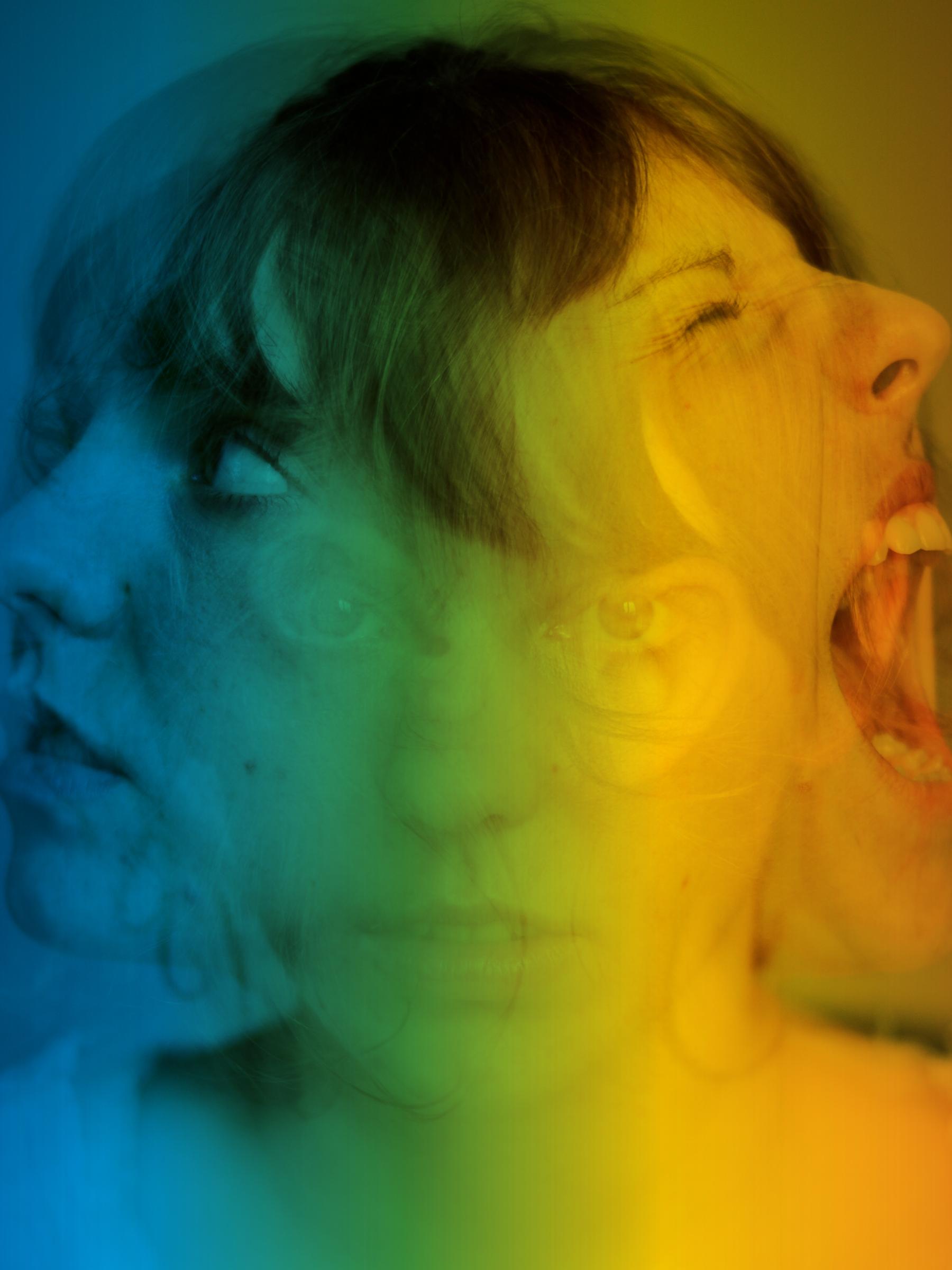

Bad Trips : "Ich dachte, das hört gar nicht mehr auf"
Horrortrip auf LSD, kompletter Kontrollverlust auf Ketamin und irrationale Angst auf Cannabis: Drei Konsumenten erzählen von ihren beängstigenden Rauscherfahrungen.
Artikelzusammenfassung
Die Zusammenfassung für diesen Artikel kann leider momentan nicht angezeigt werden.
Jonas nahm LSD, obwohl er sich eigentlich nicht wohlfühlte. Paul hatte schon Erfahrung mit Ketamin, aber nahm unvorbereitet eine viel höhere Dosis als er gewohnt war. Und Christina hatte eine schlechte Drogenerfahrung auf Cannabis, wahrscheinlich, weil es ihr psychisch nicht gut ging. Sie erzählen von ihren sogenannten Bad Trips: W as passiert, wenn der Konsum schief geht? Und was macht der Körper, während die Droge Überhand nimmt?
Außerdem haben wir einen Arzt und Chemiker gefragt, warum es den Konsumenten so ergangen ist. Thomas Polak arbeitet am Uniklinikum Würzburg in der Klinik für Psychiatrie, Psychosomatik und Psychotherapie und am Interdisziplinären Zentrum für Suchtforschung Würzburg. Er erklärt, woher die Symptome der Konsumenten gekommen sein könnten.
Jonas*, 31, erzählt von seinem Bad Trip auf LSD. Er hat mit verschiedenen Drogen Erfahrung (Cannabis, MDMA, Ketamin, Kokain, LSD).
Ich war alles andere als unerfahren, als ich den schlimmsten Trip meines Lebens hatte. Es passierte, als ich das siebte Mal LSD nahm. Alle Trips davor waren großartig. Ich würde immer noch sagen, dass LSD die beste Droge überhaupt ist. Ich hatte Momente, in denen ich Dinge anders wahrgenommen, besser verstanden habe. Ich habe mir vor jedem Trip eine Frage gestellt, oder die Erfahrung einer Person gewidmet. Zum Beispiel habe ich einmal versucht, mich in meine Mutter hineinzuversetzen, ich habe alles aus ihrer Sicht beobachtet. Das hat mir oft weit über den Trip hinaus geholfen.
Bis zu diesem Abend war ich eigentlich ein sehr gewissenhafter Drogenkonsument, ich habe mich immer gut vorbereitet. Es war mir wichtig, LSD nur in der richtigen Atmosphäre zu nehmen: lieber in der Natur und mit wenig Leuten als mitten auf einer Party. Ich habe dafür gesorgt, dass ich genug zu trinken dabei habe, auch Decken und Musik. Ich wollte auf jede Empfindung vorbereitet sein.
Thomas Polak: "Es ist schwierig, sich auf alles vorzubereiten, was während des Trips geschieht. Die Umgebung und die eigene Verfassung können das Erlebnis stark beeinflussen."
Auch auf unangenehme Erscheinungen habe ich mich eingestellt. Ich wusste, dass man manchmal Dinge sehen kann, die einem Angst machen. Das war bei zwei meiner Trips so und ich wusste, wie ich damit umgehen musste: Wenn mir das bei meinen Trips passiert ist, habe ich gesagt: "Hallo Monster, ich weiß, dass du da bist, und das ist okay, jetzt werde ich aber etwas anderes tun." Das war dann sogar ein gutes Gefühl.
Aber bei meinem siebten Trip im September 2015 habe ich mich an nichts davon gehalten – und es war die Hölle. Ich war mit vier, fünf Leuten unterwegs zum Feiern und hatte gar nicht vor, etwas zu nehmen. Dann hatte aber einer etwas dabei und bot eine Runde an. Ich kannte ihn nicht so gut, aber hatte Lust darauf. Ich bin Musiker und ich hatte gerade eine stressige Phase mit meinen Projekten, deshalb habe ich mich nach Ablenkung, Leichtigkeit und Bewusstseinserweiterung gesehnt. Also machte ich mit.
Es fing schon ein bisschen anders an als sonst. Normalerweise wird meine Wahrnehmung so ganz langsam schärfer und gleichzeitig weicher. Dann sehe ich etwa die Blätter von einem Baum wie durch eine Lupe. Diesmal ging es viel schneller, ich habe ganz plötzlich angefangen vor mich hinzukichern. Es ist so rausgesprudelt. Das war noch witzig. Ich fühlte mich kurz euphorisch, aber merkte, wie ich die Kontrolle verlor. Wir waren zu dem Zeitpunkt noch bei meinem Kumpel in der Wohnung und haben die Musik voll aufgedreht. Es war irgendwas Poppiges – gar nicht mein Fall normalerweise. Diese Musik hat mich noch nervöser gemacht. Mein Zeitgefühl war jetzt schon weg. Irgendwann hat einer vorgeschlagen, weiterzuziehen. In einen Club mit guten Lichteffekten.
- Crime Movies
- Drama Movies
The 11 Most Trippy Drug Movies With Psychedelic Experiences, Ranked
If you buy something using our links, we may earn a commission at no extra cost to you. Thanks for your support!
Remember that scene from Breaking Bad when Jesse hovers in mid-air after taking his first ever hit of heroin? It's iconic, and there's plenty more trippy drug scenes like that in cinema.
Drug abuse isn't exactly a new topic when it comes to film exploration, but most movies simply show us the character taking drugs. We rarely get to experience the drug in the character's shoes.
That's why we've compiled a list of fascinating movies that take us into the minds of drug-using characters, to witness their distorted worlds from their skewed points of view.
Here are some of the most trippy drug movies that depict the drug experience via clever cinematography and editing.
11. Mandy (2018)
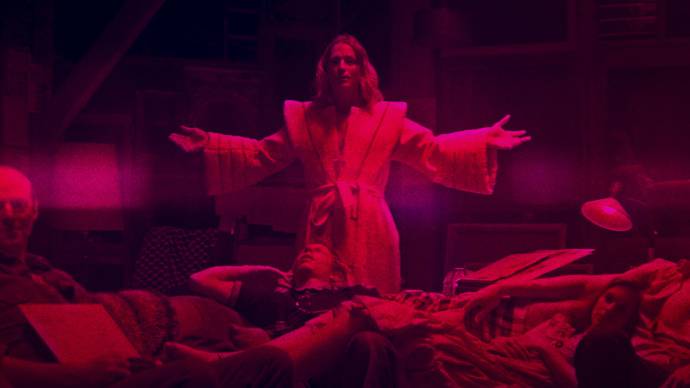
Directed by Panos Cosmatos
Starring Nicolas Cage, Andrea Riseborough, Linus Roache
Action, Fantasy, Horror (2h 1m)
6.5 on IMDb — 90% on RT
Psychedelics can lead to fun mind-expanding experiences that open gateways into whole new worlds. But they can also be traumatic.
Panos Cosmatos's psychedelic horror Mandy is like a slice of fantasy art come to life. Red saturates the screen in violent symbolism, and everything is lucid. Nicolas Cage stars as (aptly named) Red Miller, who's out for revenge when a demonic cult kidnaps his wife.
Mandy is savage and brutal, but artistically astounding. Everything is smoky, dark, and distorted. The screen is hyper-stylized with flashing satanic images and colored fog.
Potent liquid LSD gives the biker gang sadomasochistic desires, and seductive folk music lures the titular Mandy—and us—into the commune. Red consumes tainted acid mixed with cocaine, and severely hallucinates... which we watch first-hand.
10. Jacob's Ladder (1990)
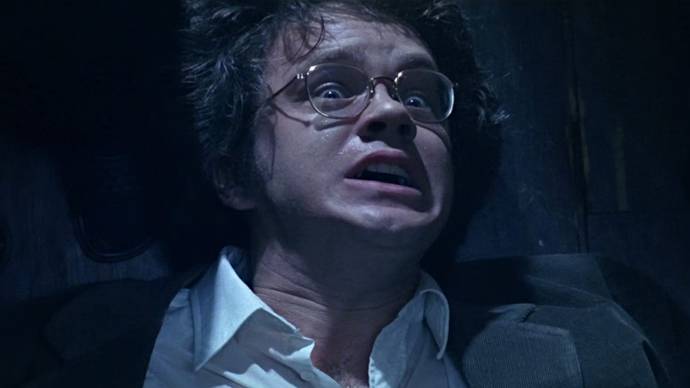
Directed by Adrian Lyne
Starring Tim Robbins, Elizabeth Peña, Danny Aiello
Drama, Horror, Mystery (1h 53m)
7.4 on IMDb — 72% on RT
Most viewers won't realize they're watching a trippy drug movie until the end of Jacob's Ladder . The effects are all laid clear at the beginning of the film, but we don't fully understand what's going on yet.
Jacob (Tim Robbins) spends the entirety of Jacob's Ladder plagued by visions of demons. They vibrate in the corners of his eyes, and he can't decide if he's going insane or if there really are devils following him.
Adrian Lyne's psychological horror is a hyperbolic depiction of the lingering effects of psychoactive drugs. Although they might not be haunted by faceless figures, LSD users often report lasting hallucinations later in life, including streaking, visual snow, and shimmering.
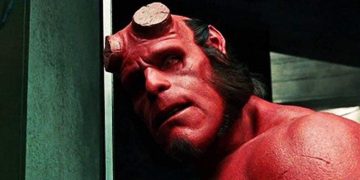
9. Flashback (2020)
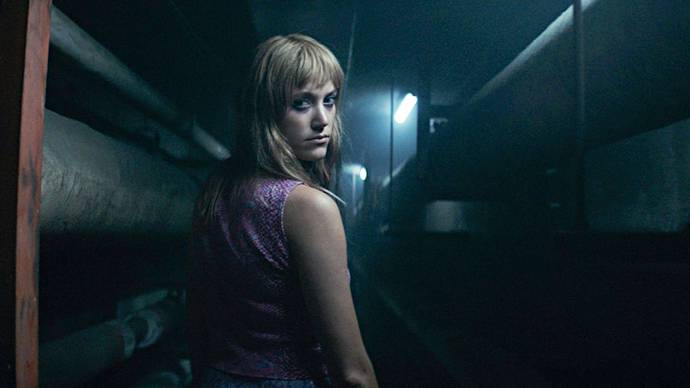
Directed by Christopher MacBride
Starring Dylan O'Brien, Maika Monroe, Hannah Gross
Drama, Mystery, Thriller (1h 37m)
5.3 on IMDb — 54% on RT
Some find Flashback (originally The Education of Frederick Fitzell ) frustrating to watch, as the plot can be a little difficult to follow. The second you think you know what's going on, it slips away again.
However, this is simply the nature of its fictional drug, so you're experiencing time in the same fractured way that Frederick (played by Dylan O'Brien) does. Which, in our opinion, is pretty neat.
Christopher MacBride directs this Canadian mystery thriller, where a dangerous new drug called "mercury" runs rife through a high school, but everyone's memory of it is hazy. As it turns out, mercury frees its user from being "trapped" in time.
When Frederick―now an adult―begins having horrible visions of a missing girl, he starts to piece the past back together. In a tangle of flashbacks and memories and timelines, a strange boy speaks to him in disjointed riddles as he figures out what's going on.
8. Altered States (1980)
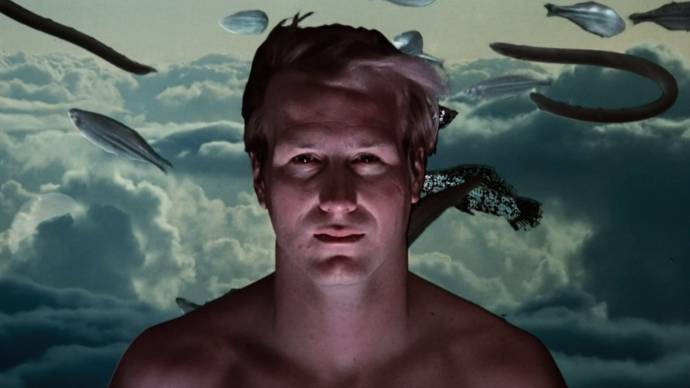
Directed by Ken Russell
Starring William Hurt, Blair Brown, Bob Balaban
Horror, Sci-Fi, Thriller (1h 42m)
6.9 on IMDb — 85% on RT
Ken Russell's body horror film is partly based on real experiments with drugs and sensory deprivation tanks, which Paddy Chayefsky wrote about in his 1978 novel.
The main hypothesis of Altered States is that "other states of consciousness are as real as our waking states." In the film, Edward Jessup (William Hurt in his striking film debut) begins to investigate with sensory deprivation. Prepare to be blown away by what follows.
Edward experiences everything from petrification to devolution, from transformation to reincarnation. The hallucinogenic sequences are a mind-bending mix of terror and fascination, heavily inspired by Biblical and ancient imagery.
It's all strongly based on John C. Lilly's research involving the influence of LSD, ketamine, and mescaline on patients inside floatation tanks back in the 1960s—and you can feel the spirit of the 60s bleed through this philosophical 80s horror.
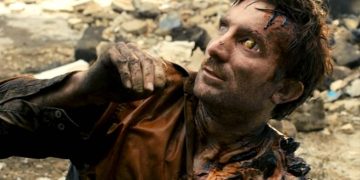
7. Synchronic (2019)
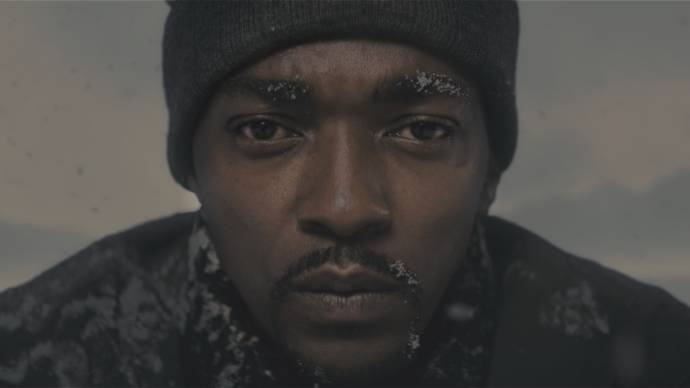
Directed by Justin Benson and Aaron Moorhead
Starring Anthony Mackie, Jamie Dornan, Katie Aselton
Drama, Horror, Mystery (1h 42m)
6.2 on IMDb — 79% on RT
Directed by Justin Benson and Aaron Moorhead, Synchronic features an imaginary time-bending designer drug.
In this movie, the pineal gland is where the "third eye" is located, and the calcification of it (due to age or fluoride consumption) limits our ability to ascend and experience higher consciousness.
A new drug named "synchronic" alters its user's perception of time via the pineal gland—and teenagers are more susceptible than adults.
Dennis (played by Jamie Dornan) and Steve (played by Anthony Mackie) are two paramedics who are called out to bizarre emergency scenes across New Orleans. Victims have been inexplicably injured, and under-the-influence witnesses babble incoherently.
When Dennis' daughter Brianna (played by Ally Ioannides) goes missing, Steve takes on the investigation by himself. Steve's cancer renders his pineal gland underdeveloped, so he's able to explore the effects of synchronic more accurately.
The drug allows Steve to travel back in time for seven minutes. But here's the catch: when you take it, your location determines what era of time you'll be sent to.
Steve goes to the Ice Age, warzones and swamps, chased by the Conquistador and Ku Klux Klan. He records and maps out his findings in order to find Brianna, who's trapped on the shores of the Mississippi River during the War of 1812.
6. Requiem for a Dream (2000)
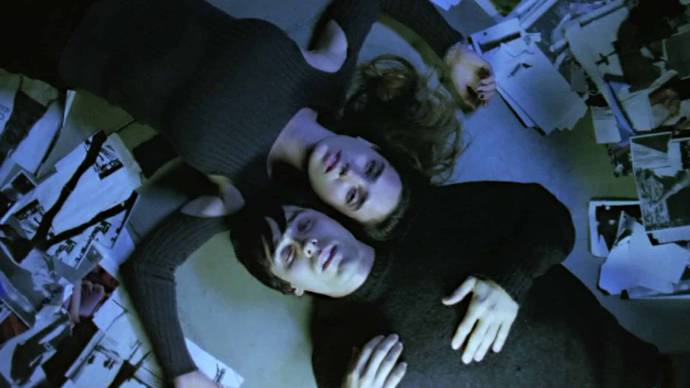
Directed by Darren Aronofsky
Starring Ellen Burstyn, Jared Leto, Jennifer Connelly
Drama (1h 42m)
8.3 on IMDb — 78% on RT
Requiem for a Dream is a dark, twisted movie that reflects the dark, twisted world of drug abuse.
The whole thing is split into two narrative strands. On the one hand, you have a trio of heroin addicts. On the other hand, you have an insecure mother (of one of the addicts) on an amphetamine diet to lose weight.
An eating disorder coupled with amphetamine psychosis makes Sara's once-boring life a living hell. Her refrigerator growls and moves like a monster. Her TV show comes to life and she finds herself inside the set while a terrifying party circles her. Meanwhile, Sara's son Harry has to have his arm amputated due to a needle infection.
Darren Aronofsky's ability to put viewers in the disorientated, desperate headspace of these characters—even with just a fish-eye lens—will leave Requiem for a Dream seared into your brain.
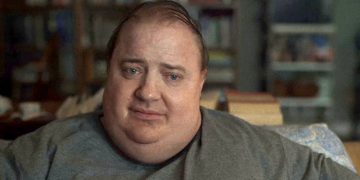
5. Midsommar (2019)
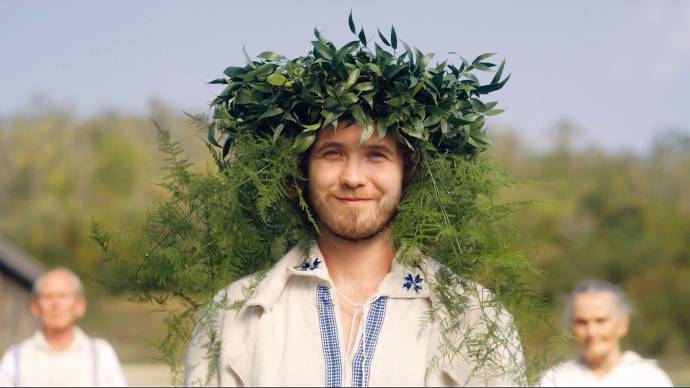
Directed by Ari Aster
Starring Florence Pugh, Jack Reynor, Vilhelm Blomgren
Drama, Horror, Mystery (2h 28m)
7.1 on IMDb — 83% on RT
Midsommar isn't a film about drugs per se, but drugs certainly feature. Ari Aster's stunning flick received knock-out reviews, delivering an uncannily bright and trippy version of the horror genre.
Most horrors are filmed in the shadows, desaturated in darkness, with the odd bit of candlelight. Midsommar , however, takes place on the rolling hills of Sweden where the sun shines, flowers grow, and it always seems to be daytime.
Dani Ardor (played by Florence Pugh) attends a midsummer celebration in rural Hälsingland with her boyfriend Chris (played by Jack Reynor). She's hesitant at first, but comes to try and strengthen their waning relationship.
Upon arrival, the guests are given magic mushrooms—and Dani has a bad trip, and we get to live that bad trip through her eyes. The screen melts and pulsates, but subtly enough for it to remain realistic. This introduces the psychedelic elements that would appear later on.
Aster clearly drew on his own experiences of the drug (which, he reassures in interviews, have always been positive), enabling us to enter that psilocybin headspace more believably.

4. Trainspotting (1996)
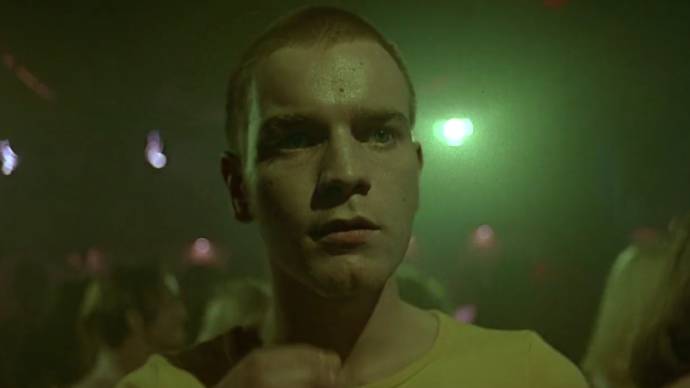
Directed by Danny Boyle
Starring Ewan McGregor, Ewen Bremner, Jonny Lee Miller
Drama (1h 33m)
8.1 on IMDb — 90% on RT
Director Danny Boyle is known for his surreal dreamscapes. Whether that's the starvation-induced hallucinations in 127 Hours or the depiction of drug culture that had The Beach banned in Thailand, Boyle loves to get a little weird.
His most loved movie, Trainspotting , is no exception. Following a group of heroin addicts, this black-comedy is filled with nightmarish scenes from the characters' points of view.
Right off the bat, we're met with the "Worst Toilet in Scotland" (an understatement). Mark Renton (played by Ewan McGregor) crawls through the revolting toilet seat and into the ocean to retrieve opiates.
Later, we see a baby crawling on the ceiling when Renton's parents force him to go cold-turkey. The infant's head spins 180 degrees, and we witness the horrors of withdrawing from class-A drugs.
Trainspotting is littered with these dark, illusionary sequences. The cult classic famously depicts the lifestyle of an addict first-hand, acting a as a social commentary on urban poverty in Edinburgh.
3. Easy Rider (1969)
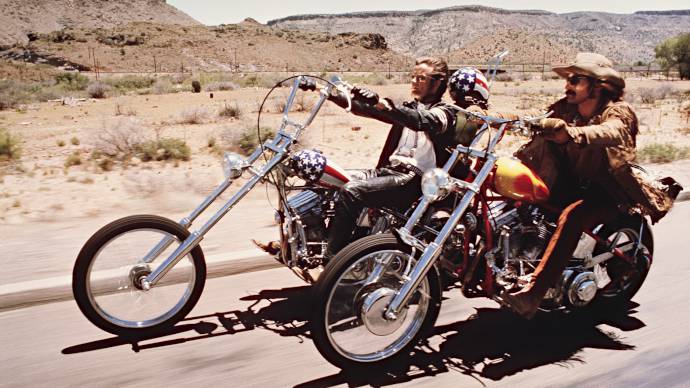
Directed by Dennis Hopper
Starring Peter Fonda, Dennis Hopper, Jack Nicholson
Adventure, Drama (1h 35m)
7.3 on IMDb — 84% on RT
Easy Rider marked the dawn of New Hollywood, effectively ending the cycle of studio-produced films from the Golden Age of Hollywood. The indie flick was revolutionary for its time, shot on location with no censorship on drug use.
Dennis Hopper's road movie follows two motorcyclists smuggling cocaine from Mexico to LA. On the way, they smoke a lot of weed and pick up a hippie hitchhiker, who invites them to a "free love" commune.
As a pinnacle movie of the 1960s, there's bound to be a lot of psychedelics. In one scene, they take a load of LSD and trip out in a graveyard. Again, we don't simply watch the scene but participate in it through Hopper's creative use of the film medium.
Quick cutting, tilted camera angles, lens flares, zooms, and erotic imagery disrupt the otherwise steady pace, signaling the switch from sanity to (temporary) insanity.
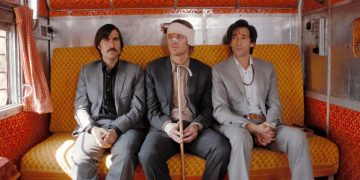
2. Enter the Void (2009)
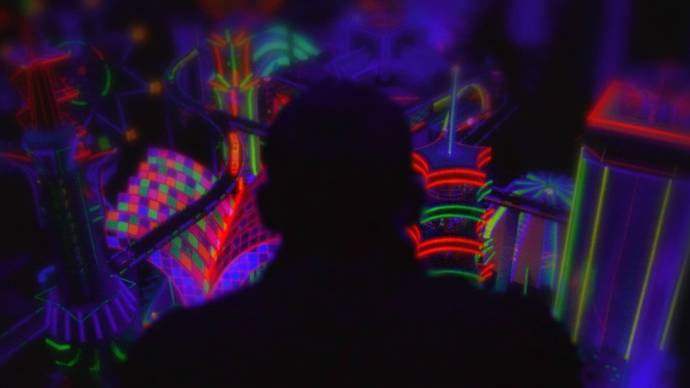
Directed by Gaspar Noé
Starring Nathaniel Brown, Paz de la Huerta, Cyril Roy
Drama, Fantasy (2h 41m)
7.2 on IMDb — 72% on RT
Enter the Void , directed by Gaspar Noé, experiments with what film can artistically achieve. Set among the blinding neon lights of Tokyo, the drama is shot from a first-person POV.
Noé describes his movie as a "psychedelic melodrama," unfolding from the out-of-body experience of Oscar (played by Nathaniel Brown).
After being shot by police for selling drugs, Oscar watches his own body from above. A non-chronological account of his life ensues, and he floats along the skies of the city in limbo between life and death.
DMT plays a huge role in Enter the Void , alongside depictions of the afterlife (mainly from a Buddhist perspective). As the entire film is shot from Oscar's viewpoint―either through his eyes or over his shoulder―we are placed fully in his shoes.
The screen blacks out when he does. We hear his private internal thoughts. We see his DMT-induced hallucinations. It's bold, trippy, and an utter cinematic marvel.
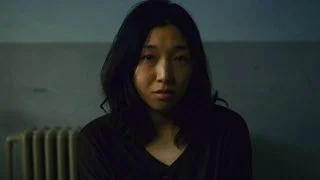
1. Fear and Loathing in Las Vegas (1998)
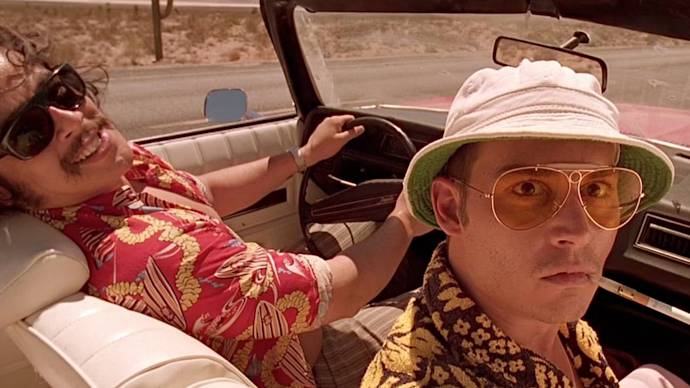
Directed by Terry Gilliam
Starring Johnny Depp, Benicio Del Toro, Tobey Maguire
Adventure, Comedy, Drama (1h 58m)
7.5 on IMDb — 50% on RT
The fact that Fear and Loathing in Las Vegas is based on a true story? Nothing short of a miracle. The amount of substances consumed by Raoul Duke (played by Johnny Depp) and Dr. Gonzo (played by Benicio del Toro) on their road trip across Nevada should have been fatal.
But alas, Hunter S. Thompson (whom the film is based on) made it out alive enough to write his experiences into a novel. Mescaline, diethyl ether, alcohol, LSD, cannabis―you name it, they take it. It all results in a torpedo ride of a movie.
Director Terry Gilliam mirrors the duo's frantic state with frantic filmmaking, cutting fast between takes, and invasively close-up camera work. The dialogue is quick and exaggerated. Everything is turned upside down.
The story is somewhat aimless and devoid of character development―but that's not the point. The point is to take the audience on a crazy, drug-fueled ride of Sunshine Acid, fast cars, and frantic psychosis, which Gilliam certainly achieves.

- Psychologie/Hirnforschung
Psilocybin: Wem droht ein Horrortrip?
Psilocybin : wem droht ein horrortrip.
Manche meinen, sie würden den Verstand verlieren. Andere glauben, zu sterben oder an der Schwelle zwischen Leben und Tod gefangen zu sein. Über Erfahrungen dieser Art berichten Menschen, die halluzinogene Drogen wie Psilocybin eingenommen haben. Forscher von der Johns Hopkins University School of Medicine haben nun festgestellt , dass die Wahrscheinlichkeit, einen solchen Horrortrip zu erleben, von der Persönlichkeit abhängt.
Roland Griffiths und seine Kollegen befragten online rund 2000 erwachsene Teilnehmer, die sie via E-Mail und über einschlägige Webseiten angeworben hatten. Ihre Probanden sollten an ihre schlimmste Erfahrung unter Einfluss von halluzinogenen Pilzen, auch bekannt als "magic mushrooms", zurückdenken und angeben, wie stark bei ihnen typische negative Empfindungen aufgetreten waren: Ängste, Trauer, körperliche Anspannung, Paranoia, Isolation, das Gefühl, verrückt zu werden oder zu sterben. Des Weiteren füllten die Teilnehmer einen Fragebogen aus, der die so genannten Big Five, die fünf Facetten der Persönlichkeit, erfasst.
Ob sich jemand als extravertiert, verträglich oder gewissenhaft beschrieb, hatte keinen Einfluss auf das Risiko eines Horrortrips. Eine andere Eigenschaft trug jedoch dazu bei: Je labiler die Probanden nach eigenen Angaben waren, desto belastender auch der Rausch. Litten sie also im Alltag häufiger unter Ängsten, Sorgen, Stimmungsschwankungen oder Stress, so lösten die Halluzinogene stärkere negative Erfahrungen aus. Das galt jedoch nicht für das Gefühl zu sterben oder tot zu sein. Diese Art von Horrortrip war bei jenen Probanden verstärkt aufgetreten, die sich für offen und intellektuell interessiert hielten. Kausal interpretieren lassen sich die Befunde allerdings nicht; theoretisch wäre es ebenfalls denkbar, dass sich die Persönlichkeit nach den Drogenerfahrungen entsprechend veränderte.
Das ist jedoch weniger wahrscheinlich, im Gegenteil: Seit einigen Jahren untersuchen Psychologen und Mediziner die therapeutische Wirkung von halluzinogenen Pilzen bei psychischen Beschwerden wie Depressionen. Auch anderen psychedelischen Substanzen werden Heilkräfte für die Seele nachgesagt . Menschen mit unheilbaren Erkrankungen können demzufolge ihre Angst vor dem Tod verlieren, wenn sie sich mittels Drogen in ungewöhnliche Bewusstseinszustände versetzen. Einige Vertreter der psychedelischen Therapie halten gerade die Konfrontation mit den "inneren Dämonen" für wirksam. Da psychisch belastete Patienten in der Regel auch emotional instabil sind, wird von Experimenten in Eigenregie allerdings abgeraten. Im Rahmen von Pilotprojekten können Psychotherapeuten hingegen negative Erfahrungen abmildern, etwa bei Angstzuständen beruhigend einwirken.
Schreiben Sie uns!
Wir freuen uns über Ihre Beiträge zu unseren Artikeln und wünschen Ihnen viel Spaß beim Gedankenaustausch auf unseren Seiten! Bitte beachten Sie dabei unsere Kommentarrichtlinien .
Tragen Sie bitte nur Relevantes zum Thema des jeweiligen Artikels vor, und wahren Sie einen respektvollen Umgangston. Die Redaktion behält sich vor, Zuschriften nicht zu veröffentlichen und Ihre Kommentare redaktionell zu bearbeiten. Die Zuschriften können daher leider nicht immer sofort veröffentlicht werden. Bitte geben Sie einen Namen an und Ihren Zuschriften stets eine aussagekräftige Überschrift, damit bei Onlinediskussionen andere Teilnehmende sich leichter auf Ihre Beiträge beziehen können. Ausgewählte Zuschriften können ohne separate Rücksprache auch in unseren gedruckten und digitalen Magazinen veröffentlicht werden. Vielen Dank!
Artikel zum Thema
Halluzinogene : mit ayahuasca auf seelenreise, neurowissenschaft : was macht lsd mit dem gehirn.
- Porträt | Der Alchemist der Seele
- Drogenkonsum | LSD unbedenklich für die Psyche
- Psychoaktive Substanzen | Mit LSD gegen Alkoholsucht
Halluzinogene : Heilsame Trips
Wenn die psyche leidet, persönlichkeit, sponsored partnerinhalte.
The New York Times
Magazine | my adventures with the trip doctors, my adventures with the trip doctors.
By MICHAEL POLLAN MAY 15, 2018
The researchers and renegades bringing psychedelic drugs into the mental health mainstream.
The Health Issue
Guided explorations.
By MICHAEL POLLAN
By SULEIKA JAOUAD
Machine Medicine
By ABRAHAM VERGHESE
Critical Care
By KIM TINGLEY
By MICHAEL POLLAN Illustrations by CHRISTOPH NIEMANN MAY 15, 2018
M y first psilocybin journey began around an altar in the middle of a second-story loft in a suburb of a small city on the Eastern Seaboard. On this adventure I would have a guide, a therapist who, like an unknown number of other therapists administering psychedelics in America today, must work underground because these drugs are illegal. Seated across the altar from me, Mary (who asked that I use a nickname because of the work she does) began by reciting, with her eyes closed, a long and elaborate prayer derived from various Native American traditions. My eyes were closed, too, but now and again I couldn’t resist peeking out for a glance at my guide: a woman in her 60s with long blond hair parted in the middle and high cheekbones that I mention only because they would, in a few hours, figure in her miraculous transformation into a Mexican Indian.
I also stole a few glances at the scene: the squash-colored loft with its potted plants and symbols of fertility and female power; the embroidered purple fabric from Peru that covered the altar; and the collection of items arrayed across it, including an amethyst in the shape of a heart, a purple crystal holding a candle, a bowl containing a few squares of dark chocolate, the personal “sacred item” that Mary had asked me to bring (a little bronze Buddha a friend brought me from Tibet) and, set squarely before me, an antique plate holding the biggest psilocybin mushroom I had ever seen.
The crowded altar also held a branch of sage and a stub of palo santo, a fragrant wood that some Indians in South America burn ceremonially, and the jet-black wing of a crow. At various points in the ceremony, Mary would light the sage and the palo santo, using the crow’s wing to “smudge” me with the smoke — guiding the spirits through the space around my head.
The whole scene must sound ridiculously hokey, not to mention laced with cultural appropriation, yet the conviction Mary brought to the ceremony, together with the aromas of the burning plants and the spooky sound of the wing pulsing the air around my head — plus my own nervousness about the journey in store — cast a spell that allowed me to suspend my disbelief. Mary trained under one of the revered “elders” in the psychedelic community, an 80-something psychologist who was one of Timothy Leary’s graduate students at Harvard. But I think it was her manner, her sobriety and her evident compassion that made me feel sufficiently comfortable to entrust her with, well, my mind.
As a child growing up outside Providence, R.I., Mary was an enthusiastic Catholic, she says, “until I realized I was a girl” — a fact that would disqualify her from ever performing the rituals she cherished. Her religiosity lay dormant until, in college, friends gave her a pot of honey infused with psilocybin for her birthday; a few spoonfuls of the honey “catapulted me into a huge change,” she told me the first time we met. The reawakening of her spiritual life led her onto the path of Tibetan Buddhism and eventually to take the vow of an initiate: “ ‘To assist all sentient beings in their awakening and enlightenment.’ Which is still my vocation.”
And now seated before her in her treatment room was me, the next sentient being on deck, hoping to be awakened. She asked me to state my intention, and I answered: to learn whatever the “mushroom teachers,” as she called them, could teach me about myself and about the nature of consciousness.
Psychedelic therapy, whether for the treatment of psychological problems or as a means of facilitating self-exploration and spiritual growth, is undergoing a renaissance in America. This is happening both underground, where the community of guides like Mary is thriving, and aboveground, at institutions like Johns Hopkins, New York University and U.C.L.A., where a series of drug trials have yielded notably promising results.
I call it a renaissance because much of the work represents a revival of research done in the 1950s and 1960s, when psychedelic drugs like LSD and psilocybin were closely studied and regarded by many in the mental health community as breakthroughs in psychopharmacology. Before 1965, there were more than 1,000 published studies of psychedelics involving some 40,000 volunteers and six international conferences dedicated to the drugs. Psychiatrists were using small doses of LSD to help their patients access repressed material (Cary Grant, after 60 such sessions, famously declared himself “born again”); other therapists administered bigger so-called psychedelic doses to treat alcoholism, depression, personality disorders and the fear and anxiety of patients with life-threatening illnesses confronting their mortality.
That all changed in the mid-’60s, after Timothy Leary, the Harvard psychologist and lecturer turned psychedelic evangelist, began encouraging kids to “turn on, tune in and drop out.” Silly as that slogan sounds to our ears, a great many kids appeared to follow his counsel, much to the horror of their parents. The drugs fell into the eager embrace of a rising counterculture, influencing everything from styles of music and dress to cultural mores, and, many thought, inspired the questioning of adult authority that marked the “generation gap.” “The kids who take LSD aren’t going to fight your wars,” Leary famously claimed. In 1971, President Nixon called Leary, who by then had been drummed out of academia and chased by the law, “the most dangerous man in America.” That same year, the Controlled Substances Act took effect; it classified LSD and psilocybin as Schedule 1 drugs, meaning that they had a high potential for abuse and no accepted medical use; possession or sale became a federal crime. (MDMA, which was still being used therapeutically, was not banned until 1985, after it became popular as a party drug called Ecstasy.) Funding for research dried up, and the legal practice of psychedelic therapy came to a halt.
But beginning in the 1990s, a new generation of academics quietly began doing psychedelics research again, much of it focusing on people with cancer. Since then, several dozen studies using psychedelic compounds have been completed or are underway. In a pair of Phase 2 psilocybin trials at Hopkins and N.Y.U., 80 cancer patients, many of them terminal, received a moderately high dose of psilocybin in a session guided by two therapists. Patients described going into their body and confronting their cancer or their fear of death; many had mystical experiences that gave them a glimpse of an afterlife or made them feel connected to nature or the universe in a way they found comforting. The studies, which were published in The Journal of Psychopharmacology in December 2016, reported that 80 percent of the Hopkins volunteers had clinically significant reductions in standard measurements of depression and anxiety, improvements that endured for at least six months.
Other, smaller studies of psilocybin have found that one, two or three guided sessions can help alcoholics and smokers overcome their addictions; in the case of 15 smokers treated in a 2014 pilot study at Hopkins, 80 percent of the volunteers were no longer smoking six months after their first psychedelic session, a figure that fell to 67 percent after a year — which is far better than the best treatment currently available. The psychedelic experience appears to give people a radical new perspective on their own lives, making possible a shift in worldview and priorities that allows them to let go of old habits.
Yet researchers believe it is not the molecules by themselves that can help patients change their minds. The role of the guide is crucial. People under the influence of psychedelics are extraordinarily suggestible — “think of placebos on rocket boosters,” a Hopkins researcher told me — with the psychedelic experience profoundly affected by “set” and “setting” — that is, by the volunteer’s interior and exterior environments. For that reason, treatment sessions typically take place in a cozy room and always in the company of trained guides. The guides prepare volunteers for the journey to come, sit by them for the duration and then, usually on the day after a session, help them to “integrate,” or make sense of, the experience and put it to good use in changing their lives. The work is typically referred to as “psychedelic therapy,” but it would be more accurate to call it “psychedelic-assisted psychotherapy.”
Though the university researchers seldom talk about it, much of the collective wisdom regarding how best to guide a psychedelic session resides in the heads of underground guides like Mary. These are the people who, in many cases, continued to do this work illicitly, long after the backlash against psychedelics during the 1960s ended most research and therapy. But their role in the current renaissance is an awkward one, as I discovered early this spring when I sat in on the nation’s first certificate program for aspiring psychedelic guides.
On a Friday afternoon in late March, 64 health care professionals of various stripes — doctors, therapists, nurses, counselors and naturopaths — gathered in Namaste Hall at the California Institute of Integral Studies (C.I.I.S.), a school of psychology and social sciences in San Francisco, to begin their training to become legal psychedelic therapists. To be admitted to the program, an applicant must have a professional medical or therapy license of some kind, and most of the trainees — whose average age looked to be about 45 and whose number included nine psychologists, nine psychiatrists and four oncologists — had enrolled in this certificate program in the belief that psychedelic drugs like psilocybin and MDMA, administered with the proper support and guidance, hold the potential to revolutionize mental health treatment. The career path might not be clear or straight yet, but these people want to be ready to lead that revolution when it arrives — which may be sooner than we think.
It quickly became clear that the reason most of the people in the room were willing to devote the time (five weekends and one full week over nine months) and the money ($7,800) to be certified as a graduate of the program is that they’d been persuaded — often by personal experience — of the therapeutic potential of these compounds. As Manish Agrawal, a rugged 48-year-old oncologist who practices in Maryland, told me, with a sardonic lift of an eyebrow, “You don’t do something like this because you read a magazine article.”
The drugs at the center of the therapy being taught — still classified by the government as Schedule 1 — cannot be used in the training, a limitation that both students and instructors lamented. (C.I.I.S. plans to petition the F.D.A. for permission to give psilocybin and MDMA to students in future trainings.) And while most of the faculty was drawn from the ranks of therapists who work in sanctioned clinical trials of psilocybin and MDMA, because so much of the relevant experience belongs to guides who have been working underground, the program draws on the wisdom of these people too. Though the program’s explicitly stated intention is to train guides to work in the world of legal psychedelic therapy, that world (apart from the handful of clinical trials) doesn’t quite exist yet, while the psychedelic underground beckons right now.
Janis Phelps, a psychologist and C.I.I.S. administrator who established and directs the program, forthrightly confronted the issue in her introductory remarks to the class Friday evening. “We are training you to be aboveground therapists,” she emphasized. “If you are thinking of working underground” — she later told me a strenuous effort had been made to weed out such people — “you need to think about that. Because we want you to be aboveground, F.D.A.-approved therapists. Everyone engaged in this research is squeaky clean.”
She looked out over the room of aspiring guides. “So I invite you into the tensions of the field as it now exists.”
Bill Richards, clinical director of the psychedelics-research program at Johns Hopkins and the author of “Sacred Knowledge: Psychedelics and Religious Experiences,” is one of the few surviving links between the first and second waves of sanctioned psychedelic research in America. A jovial, goateed psychologist in his 70s with an infectious cackle, Richards led off the weekend’s instruction on Saturday morning. Working at the Maryland Psychiatric Research Center at Spring Grove in the 1970s, Richards and his colleagues successfully treated alcoholics, cancer patients and people suffering from depression with LSD until 1976, when research at the center shut down. “How can this ever have been illegal?” Richards likes to say. “It’s as if we made entering Gothic cathedrals illegal, or museums, or sunsets!”
When research with psilocybin resumed in the 1990s, Johns Hopkins recruited Richards because of his long experience guiding patients during a high-dose psychedelic experience. Today’s researchers work with psilocybin and MDMA because a session tends to be shorter than with LSD and because the words carry much less political baggage. Since the ’60s, LSD has been associated in the public mind with the counterculture and with stories, true or not, of people jumping off buildings thinking they could fly, blinding themselves by staring at the sun or landing themselves in the emergency room after psychotic episodes. MDMA and psilocybin are less well known and don’t seem to have the same associations. (Also, the fact that psilocybin is “natural” — derived from a mushroom — seems to count in its favor.) Richards has trained many of the guides now working in clinical trials not only at Hopkins but also at N.Y.U. and at Imperial College London.
In his PowerPoint presentation, Richards laid out what has become the standard protocol for aboveground psychedelic therapy, and the role of the guide at each of the three principal stages of “the journey.” First comes a series of preparation sessions, in which volunteers are told what to expect, asked to set an intention (to quit smoking, say, or confront their fear of death) and offered a set of “flight instructions” for the journey ahead. These generally advise surrendering to the experience, whatever it brings and however disturbing it might become. (“Trust, let go, be open” is one mantra he recommends, or, borrowing from John Lennon, “Turn off your mind, relax and float downstream.”) If you feel as if you are “dying, melting, dissolving, exploding, going crazy, etc. — go ahead.” Richards stressed how important it is for the guide to quickly establish a rapport with volunteers, so that during the session “they can let themselves ‘die’ or go crazy — that requires an awful lot of trust!” Because the patients’ ego defenses are likely to be disabled by the drug, it’s crucial that they feel safe.
The second stage is the journey itself. Richards showed a slide of the Hopkins treatment room, decorated to look like the office of a psychiatrist with an interest in Eastern religion and indigenous peoples, with shelves holding large-format art books and spiritual tchotchkes, including a Buddha and a large ceramic mushroom. The volunteer stretches out on a couch and puts on eyeshades and headphones to encourage an inward journey free of distraction. (Richards has put together a playlist consisting mainly of classical compositions arranged to support and structure the experience.) Two guides, typically one male, the other female, sit with the volunteer for the duration but say very little, allowing the journey to unfold according to its own logic. Mostly the guide is present to offer a comforting hand if the journeyer is struggling, jot down anything she has to say and generally keep an eye on the volunteer’s physical well-being while she is roaming her psychic landscape. Because it is the drug and the mind that drive the journey and not the therapist, the guide’s role calls for an unusual degree of humility, restraint and patience — the sessions can last for hours. (No snoozing or checking of email; meditating, however, is O.K.) Richards describes the session as the “ pièce de résistance ” of the work, “in which you’re focused intensely on one human being as if that’s all that exists in the world. It’s a great way to get exhausted!”
The last stage is integration, which typically takes place the following day. Here the guide helps the volunteer make sense of what can be a confusing and inchoate experience, underscoring important themes and offering ideas on how to apply whatever insights may have emerged to the conduct of the volunteer’s life. The challenge, as Richards put it, is to help the volunteer transform “flashes of illumination” (he’s quoting Huston Smith, the late scholar of religion) experienced during the trip “into abiding light” — into a new, more constructive way to regard your self and situation.
It is sometimes said that in the last few decades psychiatry went from being brainless — relying on talk therapies oblivious to neurobiology — to being mindless — relying on drugs, with little attention to the contents of consciousness. If psychedelic-assisted therapy proves as effective as early trials suggest it might, it will be because it succeeds in rejoining the brain and the mind in a radical new therapeutic paradigm: using not just a chemical but the powerful mental experience it can occasion, given the proper support, to disrupt destructive patterns of thought and behavior.
Such a new approach couldn’t come at a better time for a field that is “broken,” as Tom Insel, head of the National Institute of Mental Health until 2015, told me bluntly. Rates of depression (now the leading cause of disability worldwide, according to the W.H.O.) and suicide are climbing; addictive behavior is rampant. Little has changed, meanwhile, in psychopharmacology since the introduction of SSRI antidepressants in the late 1980s. This may explain why prominent figures in the psychiatric establishment are voicing support for psychedelic research. Addressing a conference on psychedelic science in Oakland last spring, Insel and Paul Summergrad, a former president of the American Psychiatric Association, offered encouragement to the psychedelic researchers in the audience, with Insel singling out for praise “the novel approach here” — the way the psychedelic therapist combines pharmacology and psychotherapy to create a single transformative experience.
Psychedelic therapy as the idea is now understood was developed by a group of researchers working in Saskatchewan in the mid-1950s, including the psychiatrists Abram Hoffer, Humphry Osmond (who, in 1957, coined the word “psychedelic,” which loosely translates from the Greek as “mind manifesting”) and their frequent collaborator and muse, a brilliant amateur therapist named Al Hubbard. After both conducting and participating in a great many mescaline and LSD sessions — at the time it was routine for scientists to test drugs on themselves — the researchers observed how variable the experience could be, depending on circumstance and mind-set. In those days, no one knew how best to administer these strange new compounds; the need for a guide wasn’t immediately apparent. Some early scientists in white coats bearing clipboards dosed volunteers in a hospital room with white walls and fluorescent lights. Very often, the volunteers would then be left alone. Researchers didn’t yet understand that the psychedelic experience is not foreordained by the chemical but rather is “constructed” in the mind from an unpredictable mix of expectation, memory, the contents of the unconscious and a variety of environmental factors.
Beginning in the late 1950s, as the researchers began to better grasp the many factors at work, they began to work more consciously with set and setting (though the words wouldn’t be used for another few years), bringing music and images into a treatment room they made comfy and emphasizing the role of a guide. Shamans have known for thousands of years that a person in the depths of a trance or under the influence of a hallucinogenic plant like ayahuasca or peyote can be readily manipulated with the help of certain words, cues, special objects or music. They understand intuitively how the suggestibility of the human mind during an altered state of consciousness can be harnessed as an important resource for healing — for breaking destructive patterns of thought and proposing new perspective in their place. One of the Canadian group’s key contributions to psychedelic therapy was to introduce the tried-and-true tools of shamanism, or rather the Westernized version of it that, to one degree or another, most of today’s psychedelic guides still practice, whether working aboveground or below — though the tools of shamanism play a larger role in the underground.
Before my own psychedelic journey, I met and interviewed more than a dozen such guides, many of them trained by the therapists who were using psychedelics in their practices before they became illegal and decided that, rather than give up a tool they had found to be effective, they would continue to work underground, at substantial personal risk. (Beginning in 1971, possession or sale of most psychedelic drugs was punishable by a prison sentence.) One such therapist was a Bay Area Jungian psychologist named Leo Zeff, perhaps the best-known underground guide of his generation; before his death in 1988, he claimed to have “tripped” 3,000 patients and helped train 150 underground guides, many of whom are still at work.
My travels through the psychedelic-therapy underground convinced me that while the community is obviously far-flung and heterogeneous and has its complement of charlatans, many guides are professionals who share an approach and even a code of conduct. In 2010, a “wiki” for guides appeared on the internet — a collaborative website where individuals could share documents and together create new content — where, for a time, the community appeared to be codifying the rules and standards of the profession. (The site has since vanished or moved.)
On the website, I found a draft charter for would-be guides — “to support a category of profound, prized experiences becoming more available to more people” — as well as links to printable forms for legal releases, ethical agreements and medical questionnaires. (“We don’t have very good insurance,” one guide told me. “So we’re very careful.”) There was also a link to a thoughtful “Code of Ethics for Spiritual Guides,” which acknowledges that “participants may be especially open to suggestion, manipulation and exploitation.” The code stresses that it is incumbent upon the guide to disclose all the psychological and physical risks. (Compared with other psychoactive compounds, psychedelics have low toxicity and are nonaddictive. The risks are primarily psychological: In some people, they can produce short-term anxiety and paranoia and, in rare cases, psychotic episodes. In the current clinical work, an estimated 1,000 volunteers have received psilocybin without a single serious adverse event.) The code also requires that the guide obtain consent, guarantee confidentiality, protect the safety of participants at all times, “safeguard” against ambition and self-promotion and accommodate clients “without regard to their ability to pay.”
Relative to the way guiding is practiced in the aboveground clinical trials (and taught at C.I.I.S.), the underground guides I interviewed, and eventually worked with, take a somewhat more active role in choreographing the experience, bringing into the “ceremony,” as they’re apt to call it, such traditional elements as incense, tobacco and sage smoke, rattles, the singing of icaros (sacred songs) and chanting of prayers.
“There are now two distinct lineages,” I was told by an underground guide with 35 years of experience, who asked me to use a family name, Michelle. “In the Western medical model, the guide is taught never to ‘get ahead of the medicine’ ” — that is, he or she aims for a noninterventionist, back-seat role during the session, and because these are foremost scientific trials, sticks to a standardized protocol in order to minimize the number of experimental variables in play. Many underground guides find this needlessly confining.
“The journey should be customized to each person,” Michelle said. “The idea of playing the same music for everyone makes absolutely no sense.” Instead, she might choose a comforting piece to support someone struggling with a challenging trip, or put on something “chaotic and disassembling” to help break down another client’s defenses. “A healer is not just a sitter. She does stuff.” Many underground guides have traveled extensively in Mexico, Brazil and Peru to study with traditional healers; Michelle believes psychedelic therapy still has much to learn from the “earth peoples” who have made use of psychedelic plants and fungi in their healing ceremonies for thousands of years. She feels the work she does offers more scope for “creativity and intuition” than the rote clinical techniques being taught aboveground allow.
I would have preferred to have my own guided psilocybin session aboveground in the reassuring confines of a medical institution, but the teams at Hopkins and N.Y.U. weren’t currently working with so-called healthy normals (do I flatter myself?) — and I could lay claim to none of the serious mental problems they were studying. I wasn’t trying to fix anything big — not that there wasn’t room for improvement. Like many people in late middle age, I had developed a set of fairly dependable mental algorithms for navigating whatever life threw at me, and while these are undeniably useful tools for coping with everyday life and getting things done, they leave little space for surprise or wonder or change. After interviewing several dozen people who had undergone psychedelic therapy, I envied the radical new perspectives they had achieved. I also wasn’t sure I’d ever had a spiritual experience, and time was growing short. The idea of “shaking the snow globe” of my mental life, as one psychedelic researcher put it, had come to seem appealing.
In Mary, I had found an underground guide with whom I felt comfortable. Mary’s approach, in terms of dosage, also happened to approximate the aboveground experience, though she worked with whole mushrooms rather than the capsules of synthetic psilocybin used in the university trials.
“The mushroom teachers help us to see who we really are,” Mary said, as we sat across the altar from each other. “They bring us back to our soul’s purpose for being here in this lifetime.” By now I was inured to the New Age lingo. I was also impressed, and reassured, by Mary’s professionalism. In addition to having me consent to the standard “agreements” (bowing to her authority for the duration; remaining in the room until she gave me permission to leave; no sexual contact), she had me fill out a detailed medical form, a legal release and an autobiographical questionnaire that resulted in 15 pages of writing it took me the better part of a day to complete. All of which made me feel I was in good hands, even when those hands were flapping a crow’s wing around my head.
On my tongue, the dried mushroom, which was easily four inches long and had a cap the size of a golf ball, was as parched as desert sand and tasted like earth-flavored cardboard, but alternating each bite with a nibble of chocolate helped me get it down. We chatted quietly for 20 minutes or so before Mary noticed that my face was flushed and suggested I lie down and put on eyeshades. As soon as Mary put on the first song — an insipid New Age composition by someone named Thierry David (an artist thrice nominated, I later learned, in Zone Music Reporter’s category of Best Chill/Groove Album) — I was immediately propelled into a nighttime urban landscape that appeared to have been generated by a computer.
I was experiencing synesthesia, in which one sense gets crosswired with another, so that sound was creating visual space, and what I took to be David’s electronica conjured a depopulated futuristic city, with each note giving rise to another soft black stalagmite or stalactite that together resembled the high-relief soundproofing foam used to line recording studios. I moved effortlessly through this digital nightscape as if within the confines of a dystopian video game. Though the place wasn’t particularly frightening and had a certain sleek beauty, I hated being in it and wished to be somewhere else, but it went on and on, seemingly forever. I asked Mary to please play something else, and though the mood shifted with the new music, I was still stuck — trapped — in this sunless computer world. Why, oh why, couldn’t I be outside?
This could easily take a terrifying turn, it occurred to me, and with that a dim tide of anxiety began to build. Recalling the flight instructions, I told myself there was nothing to do but let go and surrender to the experience. Relax and float downstream. I realized I was no longer captain of my attention, able to direct it this way or that and change the mental channel at will. No, this was more like being strapped into the front car of a cosmic roller coaster, its heedless headlong trajectory determining moment by moment what would appear in my field of awareness.
Actually, that’s not entirely true: All I had to do was remove my eyeshades, and reality, or at least something loosely based on it, would re-present itself. This is what I now did, partly to satisfy myself that the world still existed but mostly because I badly needed to pee. Sunlight and color flooded my eyes, and I drank it in greedily, surveying the room for the welcome signifiers of nondigital reality: walls! Windows! Plants! But this reality appeared in a new aspect: jeweled with morning light, every beam of it addressed to my eyes. I got up carefully from the mattress, and Mary took me by the elbow, geriatrically, and together we made the long journey across the loft to the bathroom. I avoided looking at her, uncertain what I might see in her face or betray in mine.
After producing the most spectacular crop of diamonds, I made my unsteady way back to the mattress and lay down. Mary, speaking softly, asked if I wanted “a booster.” I sat up to receive another mushroom, for a total of about four grams. Mary was kneeling next to me, the mushroom in her upturned palm, and when I finally looked up into her face, I saw she had turned into María Sabina, the Mazatec curandera whom I had read about. Sixty years ago, Sabina gave psilocybin mushrooms to R. Gordon Wasson, supposedly the first Westerner to try them, in a dirt-floored basement of a thatch-roofed house in the remote mountains of Oaxaca. Mary’s hair was now black; her face, stretched taut over its high cheekbones, was anciently weathered; and she was wearing a simple white peasant dress. I took the desiccated mushroom from the woman’s wrinkled brown hand and looked away as I chewed; I didn’t think I should tell Mary what had happened to her.
When I put my eyeshades back on and lay down, I was disappointed to find myself back in computer world, but something had changed, no doubt a result of the stepped-up dose. Whereas before I navigated this landscape as myself, taking in the scene from a perspective recognizable as my own, with my attitudes intact (highly critical of the music, for instance), now I watched as that familiar self began to fall apart before my eyes, gradually at first and then all at once.
“I” now turned into a sheaf of little papers, no bigger than Post-its, and they were being scattered to the wind. But the “I” taking in this seeming catastrophe had no desire to chase after the slips and pile my old self back together. No desires of any kind, in fact. And then I looked and saw myself out there again, but this time spread over the landscape like paint, or butter, thinly coating a wide expanse of the world with a substance I recognized as me.
But who was this “I” that was able to take in the scene of its own dissolution? Good question. It wasn’t I, exactly. Here the limits of our language become a problem: In order to completely make sense of the divide that had opened up in my perspective, I would need a whole new first-person pronoun. For what was observing the scene was a vantage and mode of awareness entirely distinct from my accustomed self. Where that self had always been a subject encapsulated in this body, this one seemed unbounded by any body, even though I now had access to its perspective. That perspective was supremely indifferent, unperturbed even in the face of what should have been an unmitigated personal disaster. The very category “personal,” however, had been obliterated. Everything I once was and called me, this self six decades in the making, had been liquefied and dispersed over the scene. What had always been a thinking, feeling, perceiving subject based in here was now an object out there. I was paint!
Lots of other things happened in Mary’s room, and in my head, during the course of my journey that day. I gazed into the bathroom mirror and saw the face of my dead grandfather. I trudged through a scorched desert landscape littered with bleached bones and skulls. One by one appeared the faces of the people in my life who had died, relatives and friends and colleagues whom, I was being told, I had failed properly to mourn. I beheld Mary transformed once again, this time into a ravishing young woman in the full radiance of youth; she was so beautiful I had to turn away.
At one point Mary put on one of Bach’s unaccompanied cello suites. It was the suite in D minor, a spare, infinitely sad piece that I’d heard many times before, often at funerals. But this time was different, because I heard it in my egoless, nondual state of consciousness — though “heard” doesn’t do justice to what transpired between Bach’s notes and me. The preposition “between” melted away. Losing myself in the music became a kind of rehearsal for losing myself, period. I let go of the rope of self and slipped into the warm waters of this ineffable beauty — Bach’s sublime notes, I mean, drawn from a cello’s black well of space by Yo-Yo Ma’s mournful bow as it surfed across its strings. I became identical to the music, a word that doesn’t begin to describe the power of what these unearthly vibrations were, or explain how they somehow lifted up and carried me beyond the reach of all suffering and regret.
The sovereign ego, with all its armaments and fears, its backward-looking resentments and forward-looking worries, was simply no more, and there was no one left to mourn its passing. And yet something had succeeded it: this bare, disembodied awareness, which gazed upon the scene of the self’s dissolution with benign indifference. I was present to reality but as something other than my usual self. And although there was no self left to feel, exactly, there was a feeling tone, and that was calm, unburdened, content. There was life after the death of the ego.
The Sunday-morning session at C.I.I.S. began with great anticipation — the speaker was Ralph Metzner, who worked with Timothy Leary at Harvard and is regarded as one of the wise elders in the psychedelic community.
Metzner is in his 80s now, and stepping up to the microphone in his newsboy’s cap, he seemed frail. For much of his presentation, he read from one of his books — something about the soul and the six archetypal paths through this life. It wasn’t until the Q. and A. that things got interesting.
A student who identified himself as a psychotherapist asked Metzner to talk about psychedelics, a subject he hadn’t yet mentioned. With that gentle nudge, Metzner proceeded to veer wildly off message, exposing the tensions that Janis Phelps alluded to Friday night but that had been absent from the weekend’s presentations thus far. “These are drugs that psychotherapists unanimously feel could improve psychotherapy,” Metzner began, “but their use is illegal. What does that tell you? Something about the society we live in!”
Metzner paused — and then jumped. “There is a vast underground network of psychedelic therapy, you know — vast. Larger than the approved uses of psychedelic therapy.” He went on: “It’s an underground culture, and underground cultures are good, in fact they can be lifesaving.” Phelps, her porcelain complexion reddening, stood up, taking a step toward the lectern to solicit another question, but Metzner wouldn’t be deterred. Declaring that we were in the midst of a spiritual emergency in this country, he told the students we have these “fantastically promising medicines that can cure all sorts of ills, and yet doctors can’t get them.”
Metzner’s voice rose. “We don’t have to accept that!” The eminent professor seemed to be inviting his flock to engage in a collective act of civil disobedience. This he likened to the underground in Germany, where he grew up, during the war: “There were German families who took in Jewish families and hid them in their closets.” He voiced impatience with the pace of scientific research and federal approval, “at a time of civilizational collapse,” when we have these medicines that we know work and could help our society right now. “It doesn’t need to be proven over and over again. When there’s a plague, you don’t go through double-blind placebo-controlled studies! It’s a plague!”
Finally it fell to Bill Richards to stand up and gently remind the students that while the pace of progress might be frustrating, “we have a path forward” — the path of sanctioned clinical trials leading to approval of psychedelic therapy. He pointed out that the researchers on this path had so far found federal regulators to be remarkably open and receptive. “So let’s go forward as scientist-warriors and do what we can in the aboveground world. I think we can make a significant impact.”
The students I spoke to afterward clearly shared Metzner’s sense of urgency and frustration, but they rejected his apparent invitation to join the underground. In their view, Metzner was looking backward, to a dark age when the underground served as the saving ark of psychedelic therapy. But that dark age was drawing to a close, they believed. A generation or two younger than Metzner, these people were looking resolutely forward — to a time, not too distant they thought, when the F.D.A. would approve the therapeutic use of psilocybin and MDMA and make them available to doctors to prescribe to their patients. This was the future they had signed up for when they enrolled in the course.
One student in the class, a psychiatrist who had participated in psychedelic therapy in South America for decades, told me after the session that she was now fully committed to the legal road. “I’ve had a secret life for 30 years,” she said. “I damn well want this opportunity to unify my life. Because of this class, I have a way to talk openly to people about psychedelics for the first time.” She voiced deep respect for Metzner but believed the time had come to make a choice. “I don’t want to lose the history or the knowledge we’ve gained from the underground work. But the professionals in this room have decided to put our time and credentials into furthering the legal use of these medicines.” Doing so, she said, “demands being beyond reproach so as not to endanger the work and the path that has been set out.”
Manish Agrawal, the Maryland oncologist, expressed the general sentiment in an email he sent me after Sunday’s session. He shared Metzner’s “frustration that this therapy isn’t available for my patients today, and many will suffer and die without access to this therapy. Ralph really pushed me to feel the injustice of that.” He went on: “But everyone senses how close we are,” and doesn’t want to jeopardize that by following Metzner off the legal route. Agrawal left San Francisco determined to find a way to incorporate psychedelic therapy in his oncology practice.
The day after my journey, I was grateful for the opportunity to return to Mary’s room for a couple of hours of “integration.” Without it, people might be tempted to dismiss their psilocybin journeys as simply a “drug experience,” put it in that handy box and throw it away; this has no doubt been the fate of a great many psychedelic trips. Yet though it is true that a chemical started me on this journey, it is also true that everything that I experienced I experienced: These are events that took place in my mind, psychological facts that were neither weightless nor evanescent. But I needed help making sense of them and putting them to use.
That I could survive the dissolution of my ego and its defenses was surely something to be grateful for, and we talked at length about this. What a remarkable gift: to learn that we can let go of so much — the desires, fears and defenses of a lifetime! — without suffering complete annihilation. This might not come as a surprise to Buddhists or serious meditators, but it was news to me, who had never felt anything but identical to my ego. Could it be that there is another ground on which to plant our feet? For the first time, I began to understand what the volunteers in the cancer-anxiety trials were telling me — how it was that a single psychedelic journey granted them a perspective from which the very worst life can throw at us could be regarded objectively and accepted with equanimity. I had been given a glimpse of that liberating perspective.
“That alone seems worth the price of admission,” Mary offered, and I had to agree. I also realized that I never would have achieved that perspective had Mary not guided me, creating a space where I felt safe enough to let go of my accustomed self and its usual defenses.
Yet 24 hours later, my old ego was back in uniform and on patrol, so what long-term good was that beguiling glimpse of a loftier perspective? Mary suggested that, having had a taste of a different, less defended way to be, I might learn to relax the ego’s trigger-happy command of my reactions to people and events. “Now you have had an experience of another way to react — or not react. That can be cultivated.” She suggested meditation as one way to do that.
Many researchers believe that the experience of “ego dissolution” that I had in Mary’s room can disrupt destructive patterns of thought and behavior and open us to new perspective from which to view death or addiction or depression. This was understood back in the 1950s and ’60s, when psychiatrists working with psychedelics sometimes described it as “therapy by self-transcendence.”
If the ego can be said to have an address, it would probably be in something called the default mode network, a high-level hub in the brain linking the frontal cortex to older centers of memory and emotion. The D.M.N. appears to be involved in a range of operations related to our sense of self, like rumination, time travel (contemplating the past and future), theory of mind (the ability to impute mental states to others) and the so-called autobiographical self: It helps us integrate whatever’s happening to us now with the story of who we are, thereby giving us an abiding sense of a self that is consistent over time. Neuroscientists recently began imaging the brains of people on psilocybin or LSD, and they were surprised to find that, rather than increasing brain activity, as you might expect, the drugs radically quieted traffic in the D.M.N. In particular, when volunteers report the experience of ego dissolution, their brain imaging shows a precipitous drop in D.M.N. activity.
Taking this network temporarily offline may allow the whole system to “reboot,” in the words of Robin Carhart-Harris, a pioneering neuroscientist who has done extensive work imaging tripping brains at Imperial College London. The “loosening of cognition” that results, he says, is especially helpful to people suffering from the varieties of mental stuckness, including depression, addiction, anxiety and obsession.
All these conditions, as Alison Gopnik, a professor of psychology at Berkeley, points out, may share an etiology. “There are a range of difficulties and pathologies in adults, like depression, that are connected with the phenomenology of rumination, and an excessively narrow, ego-based focus,” says Gopnik, whose research explores the consciousness of children, which she believes bears a similarity to psychedelic consciousness. “You get stuck on the same thing, you can’t escape, you become obsessive, perhaps addictive. It seems plausible to me that psychedelic experience could help get us out of those states, create an opportunity in which the old stories of who we are might be rewritten.”
Just how soon might psychedelic-assisted psychotherapy be available aboveground, to the many people who stand to benefit from it? Before the F.D.A. approves a new medicine, the drug must survive testing for safety and efficacy in a three-stage sequence of trials, each of them involving a larger sample and more rigorous methods. When researchers recently brought to the F.D.A. the results of Phase 2 clinical trials of cancer patients who were given psilocybin and MDMA, they were stunned by the positive response of the regulators. Regulators told them they could move forward to Phase 3 with MDMA, the last step before F.D.A. approval. The F.D.A. is still considering when psilocybin trials can move into Phase 3. The agency wouldn’t comment on drugs in the approval process, but a researcher who attended one of these meetings told me the regulators seemed untroubled by the illicit status of the drugs in question or by the unique challenges of controlling studies of psychedelics. These meetings took place before a Trump-appointed F.D.A. commissioner was sworn in; it remains to be seen how the Justice Department under Jeff Sessions would respond to F.D.A. approval of psychedelics. The researchers felt heartened by the F.D.A.’s response. The message the scientists took away from the meeting was that they should raise their sights and not limit themselves to treating cancer patients, but rather test the drugs on the much larger population of patients suffering from major depression.
Thus encouraged, the Multidisciplinary Association for Psychedelic Studies (MAPS), a nonprofit that has been working for federal approval of psychedelics since 1986, will begin Phase 3 trials of MDMA-assisted psychotherapy this summer for the treatment of post-traumatic stress disorder, involving more than 200 volunteers at 16 sites in the United States, Canada and Israel. Later this year, pending F.D.A. approval, two Phase 3 trials of psilocybin — one for the treatment of major depression and the other for “psychospiritual distress” in cancer patients — are expected to get underway at Hopkins, N.Y.U. and a half-dozen other sites around the country.
Phase 3 trials, which typically involve hundreds of subjects at dozens of sites, can cost tens of millions of dollars — a cost ordinarily borne by the big pharmaceutical companies that stand to profit from approval. But Big Pharma has not demonstrated significant interest in psychedelics, and it’s not hard to see why: Psychedelic therapy is a rather square peg to fit into the round hole of psychopharmacology as we now know it. Patents on the molecules in question — LSD, psilocybin and MDMA — have long since expired (psilocybin comes from a common mushroom); the drugs, if approved, don’t need to be taken more than a few times; and as the C.I.I.S. program recognizes, psychedelic-assisted psychotherapy is a novel hybrid of pharmacology and talk therapy, making it uncharted territory for a pharmaceutical industry organized around the selling of pills.
But the obstacle of funding Phase 3 trials appears to have been recently surmounted. The Psychedelic Science Funders Collaborative (P.S.F.C.), a new Bay Area-based consortium of philanthropists including the hippie-soap entrepreneur David Bronner, the author and tech investor Timothy Ferriss and other donors both in and out of the tech community, has helped raise more than $63 million in charitable contributions, an amount that could be sufficient to complete the trials. The two main beneficiaries of these funds will be MAPS and Usona Institute, a nonprofit medical-research organization that is sponsoring forthcoming psilocybin trials. Rebekah Mercer, the Trump funder behind Cambridge Analytica and Breitbart, is also a donor to MAPS.
There is at least one corporation betting that psychedelic therapy will soon become a business. Founded in London by George Goldsmith, a health care industry consultant, and Ekaterina Malievskaia, a physician, Compass Pathways aims to become the world’s first psychedelic pharmaceutical company. (The couple, who are married, were inspired to expand access to psilocybin after Malievskaia’s college-age son was successfully treated by an underground guide with the drug for a debilitating case of depression.) Compass aims to be much more than a drug company, however. The company is developing a complete treatment package — consisting of a training program for therapists; protocols for orchestrating the entire experience; and the medicine itself — that it hopes to sell to health care institutions and national health services, first in Europe and then in the United States.
Its initial therapeutic target is treatment-resistant depression (patients who have failed to respond to at least two previous treatments); after an advisory process with the European Medicines Agency (the E.U.’s drug-regulating body), it has decided to conduct trials in eight to 10 sites across Europe. It is also in discussions with the F.D.A. to organize trials here. According to Goldsmith, Compass has already raised $13 million from investors in the United States and Europe, many of them from the tech community (Peter Thiel is an investor) but also institutional investors in the health care sector.
Phase 3 trials will take at least three years, but access to psychedelic therapy could come sooner than that. Under “expanded access” or “compassionate use” programs, patients who stand to benefit from therapies still deemed experimental can gain access to them before trials are complete. In the case of MDMA, this could happen as soon as 2020.
That tantalizing possibility is very much on the minds of the C.I.I.S. students. On the flight home, Manish Agrawal and his oncology partner Paul Thambi began planning how to talk to their colleagues about the idea of adding psychedelic therapy to their practice, and where in their offices they might create a treatment room. Did they plan to hire guides to conduct the sessions? Perhaps, they said, but the weekend had left them both convinced this was work they very much wanted to do themselves.
“We don’t die well in this country,” Agrawal told me during a lunch break at the weekend course. “And we have pretty limited tools to help people deal with their fear. Prozac doesn’t work. The issue isn’t depression; it’s facing your mortality.” The oncologists’ commitment to training as psychedelic guides is notable; they would most likely be able to prescribe psilocybin once it’s approved without years of experience, a prospect that concerns some of the underground guides I interviewed. “Just because you have the ability to prescribe,” one guide told me, “doesn’t mean you have the wisdom to guide the experience.”
In the wake of the weekend’s high hopes, I couldn’t help wondering what the brave new world of legal psychedelic therapy might mean for guides like Mary and Michelle. I had heard some grumbling in the community about the limitations of the C.I.I.S. training, and the bitter twist that the psychedelic guides with the deepest experience could be excluded in favor of newly credentialed guides with no real-world experience whatsoever.
But Michelle said she is busier than ever. Mary, too, anticipates that federal approval of psychedelic medicine would bring more people to her door, especially those without an obvious pathology — the curious, the spiritual seeking and the legions of run-of-the-mill neurotics who already fill therapists’ offices. How many of them will want to try a guided psychedelic journey once they hear about it?
“I don’t think it’s going to hurt me at all,” Mary told me. “If anything, it will allow me to do even more than I do.” Was she worried about a crackdown if psychedelic therapy suddenly becomes fashionable? The work was too important to let that stop her. “I need to find a way to continue to protect myself, as I help people find their soul’s purpose in this lifetime, to help them awaken.”
This article is adapted from “How to Change Your Mind: What the New Science of Psychedelics Teaches Us About Consciousness, Dying, Addiction, Depression, and Transcendence,” published by Penguin Press. Read the book review here .
Sign up for our newsletter to get the best of The New York Times Magazine delivered to your inbox every week
Michael Pollan is a longtime contributing writer for the magazine. His most recent article was about the Obama administration’s record on food and farming issues . Pollan is the author of eight books, including “The Omnivore’s Dilemma,” “In Defense of Food” and “The Botany of Desire”; parts of all three appeared in the magazine.
More in this issue
The prisoners who care for the dying and get another chance at life, how tech can turn doctors into clerical workers, trying to put a value on the doctor-patient relationship, more on nytimes.com.
Advertisement
check yourself
Home > News > Topthemen > Topthema vom Oktober 2020
Was bei einem Trip auf Pilzen passieren kann
Oktober 2020
Im Herbst sprießen wieder die Pilze aus dem Boden. Manche Exemplare enthalten den Wirkstoff Psilocybin, der halluzinogene Effekte auslöst. Der Rausch birgt jedoch schwer kalkulierbare Risiken.
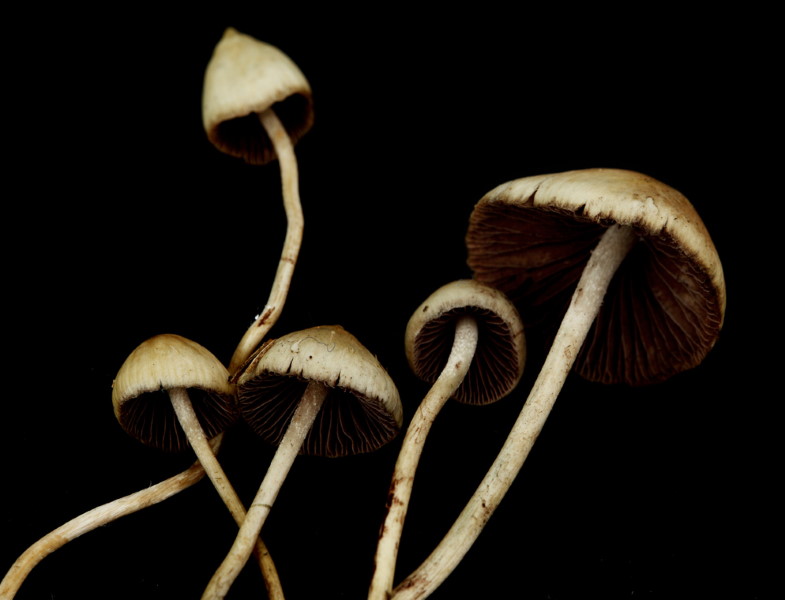
Bild: IvanMikhaylov / istockphoto.com
Sie konnten ihn nicht aufhalten. Ein 18-Jähriger konsumierte im Freundeskreis Psilocybin-Pilze , auch bekannt als Magic Mushrooms. Zwei Personen nahmen ebenfalls Pilze, eine weitere Person beschränkte sich aufs Kiffen. Während der Session habe sich der 18-Jährige im Bad zunächst von den anderen isoliert. Plötzlich sei er nackt wieder herausgekommen, habe sich ungewöhnlich aggressiv verhalten und den starken Drang gezeigt, vom Balkon zu springen.
Die beiden anderen Personen, die ebenfalls auf einem Pilztrip waren, seien zu sehr mit sich selbst beschäftigt gewesen, um eingreifen zu können. Die Person, die nur bekifft war, habe noch versucht, ihn davon abzuhalten, konnte das Unglück aber nicht verhindern. Den Sturz aus dem zweiten Stock hat der 18-Jährige nicht überlebt.
Tödliche Unfälle nach Psilocybin sind selten, kommen aber vor
Wie konnte das passieren? Untersuchungen des Mageninhalts sowie weitere Blut- und Urinanalysen ließen den Schluss zu, dass er tatsächlich nur unter dem Einfluss von Psilocybin stand. Der Cannabiswirkstoff THC konnte nur in geringer Konzentration nachgewiesen werden. Dies deute darauf hin, dass der letzte Joint schon etwas zurücklag und zum Zeitpunkt des Unglücks keine Rolle gespielt hat.
Der 18-Jährige habe die Pilze in seiner Wohnung selbst angebaut. Seine Freunde hätten angegeben, dass er die Pilze in der Vergangenheit konsumiert habe, um seine Schüchternheit zu überwinden. Als Erklärung für sein Verhalten, reicht das aber sicherlich nicht aus. Andere Anzeichen von psychischen Problemen habe es nicht gegeben.
Das Ärzteteam, das über den Fall berichtet, hat weitere Fälle recherchiert. Tödlich verlaufende Unglücke scheinen den Recherchen zufolge zwar selten zu sein, kommen aber hin und wieder vor. Der Fall des 18-Jährigen demonstriere nach Einschätzung der Autorinnen und Autoren, dass ein Trip auch unter scheinbar sicheren Bedingungen, wie dem Konsum im Freundeskreis, mit unkalkulierbaren Risiken verbunden sein kann.
Geringe Giftigkeit, aber psychische Ausnahmesituation
Die unmittelbare Giftigkeit von Psilocybin sei hingegen eher gering. Aufgrund von Tierexperimenten mit Ratten könne hochgerechnet werden, dass ein erwachsener Mensch etwa 17 Kilogramm frische Psilocybin-Pilze essen müsste, um eine potentiell tödliche Dosis aufzunehmen. Da der Körper bei dieser Menge in der Regel mit Übelkeit und Erbrechen reagiert, sei aber nicht zu erwarten, dass Konsumierende an der unmittelbaren Wirkung versterben. Es sei vor allem unerwartetes Verhalten, das im Rausch lebensgefährliche Unfälle nach sich ziehen kann.
Dennoch kann die Dosis eine Rolle spielen. Je höher die konsumierte Menge an Psilocybin, desto höher steigt die Wahrscheinlichkeit für besonders intensive Rauschverläufe. Insbesondere bei unerfahrenen, aber auch bei erfahrenen Personen könne der Rausch psychische Ausnahmesituationen hervorrufen. Das zeigt eine Umfrage unter Konsumierenden, an der knapp 2.000 Personen teilgenommen haben.
Horror-Trip auch unter erfahrenen Konsumierenden
Studienleiter Roland Griffiths und sein Team von der Johns Hopkins Universität in den USA baten die Befragten, sich an ihren schlimmsten Horror-Trip auf Pilzen zu erinnern und Angaben hierzu zu machen. Wie durchaus zu erwarten war, haben überwiegend Personen teilgenommen, die mehrmals Erfahrung mit halluzinogenen Pilzen gemacht haben. Vor ihrem schlimmsten Horrortrip seien zwischen sechs und zehn Konsumepisoden mit Pilzen vorausgegangen. Zum Zeitpunkt der Befragung waren sie im Schnitt 30 Jahre alt.
Etwa drei Viertel der Befragten gab an, dass sie vor ihrem Horror-Trip eigentlich guter Dinge waren. Die meisten haben im Freundeskreis konsumiert und fühlten sich gut darin aufgehoben. Allerdings hatten nur drei Prozent der Befragten einen „Tripsitter“ an der Seite. Das ist eine Person, die nüchtern bleibt, und im Falle des Falles helfend eingreifen kann.
Eines der einschneidendsten Erlebnisse ihres Lebens
Für 62 Prozent der Befragten zählte der angesprochene Horror-Trip zu den psychisch belastendsten Ereignissen, die sie jemals erlebt hätten. Für eine von zehn Personen war der Psilocybin-Trip sogar die einschneidendste Erfahrung, die ihnen jemals widerfahren sei. Dabei zeigte sich eine Dosis-Wirkungs-Beziehung: Je mehr Psilocybin-Pilze sie gegessen hatten, desto heftiger war der Trip.
Zu einem ähnlichen Ergebnis kommt auch eine Studie, in der schriftliche Erfahrungsberichte von Konsumierenden ausgewertet wurden. Hauptgrund für einen Horror-Trip waren den Ergebnissen zufolge beängstigende Veränderungen der Gedankenwelt. Insbesondere Paranoia , also das unbestimmte, aber bedrohliche Gefühl beobachtet oder verfolgt zu werden, scheint den Horror-Trip zu kennzeichnen.
In der Befragung der Johns Hopkins Universität gaben die meisten an, dass sie versucht hätten, sich selbst in Gedanken oder durch Selbstgespräche wieder zu beruhigen. Vielen sei dies auch gelungen. Andere hätten die Situation durch einen Ortswechsel entspannen können oder haben Freunde um Hilfe gebeten. Allerdings hat ein Teil der Befragten auch von kritischen Ereignissen berichtet.
Etwa eine von zehn Personen habe durch ihr Verhalten sich selbst oder andere dem Risiko ausgesetzt, körperlich Schaden zu nehmen. Drei von Hundert Befragten berichteten, dass sie aggressiv oder gewalttätig geworden seien. Ebenso viele mussten noch während ihres Pilztrips in einem Krankenhaus behandelt werden.
Suizidgedanken und psychotische Symptome
Eine von vier Personen litt noch eine Weile nach dem Trip an psychischen Problemen, unter anderem an Angststörungen, Depressionen und Paranoia. Bei manchen Personen markierte der Pilztrip den Beginn länger anhaltender psychotischer Symptome. Darunter waren Halluzinationen wie das Hören oder Sehen von Dingen, die nicht da sind. Auch eine schwere Form der Depersonalisation wurde berichtet. Das ist ein Phänomen, bei dem das eigene Denken und Erleben als fremd oder unwirklich erlebt wird.
Darüber hinaus gaben unter den knapp 2.000 Befragten fünf Personen an, während des Trips verstärkt an eine Selbsttötung gedacht zu haben. So habe eine Person versucht, sich mit einer Überdosis Benzodiazepine umzubringen und sei auf der Intensivstation eines Krankenhauses erwacht.
Griffith und sein Team warnen daher vor einer unkontrollierten Einnahme von Pilzen. Einige der Befragten hätten zum Teil sehr ernsthafte akute Probleme erlitten, die „nicht trivial“ seien.
Der Konsum von psychedelischen Pilzen mit dem Wirkstoff Psilocybin kann starke halluzinogene Effekte auslösen. Wie sich der Trip entfaltet, ist nur schwer vorhersehbar. Je höher die Dosis, desto eher kann der Trip außer Kontrolle geraten. Fallberichte und Befragungen zeigen auf, dass auch unter scheinbar guten Bedingungen, erfahrene Konsumierende in psychische Ausnahmesituation geraten können, die von starker Angst geprägt sind. In seltenen Fällen ereignen sich durch das Verkennen der Realität auch Unfälle, die tödlich enden.
- Bienemann, B., Ruschel, N. S., Campos, M. L., Negreiros, A. &Mograbi, D. C. (2020). Self-reported negative outcomes of psilocybin users: A quantitative textual analysis. PLoS ONE, 15(2), e0229067.
- Carbonaro, T. M., Bradstreet, M. P., Barrett, F. S., MacLean, K. A., Jesse, R., Johnson, M. W. & Griffiths, R. R. (2016). Survey study of challenging experiences after ingesting psilocybin mushrooms: Acute and enduring positive and negative consequences. J Psychopharmacol., 30(12), 1268-1278.
- Chi, T. & Gold, J. A. (2020). A review of emerging therapeutic potential of psychedelic drugs in the treatment of psychiatric illnesses. Journal oft he Neurologicaal Sciences, 411, 116715.
- Honyiglo, E., Franchi, A., Cartiser, N., Bottinelli, C., Advenier, A.-S., Bévalot, F. & Fanton, L. Unpredictable Behavior Under the Influence of “Magic Mushrooms”: A Case Report and Review of the Literature. Journal of Forensic Sciences, 64(4), 1266-1270.
- Van Amsterdam, J., Opperhuizen, A. & van den Brink, W. (2011). Harm potential of magic mushroom use: A review. Regulatory Toxicology and Pharmacology, 59, 423-429.
Um Kommentare schreiben zu können, musst du dich anmelden oder registrieren .
Umfrage dieses Monats
Frühere topthemen.

weitere Topthemen

Trage bitte deine E-Mail ein und wähle das gewünschte Newsletter- Format aus:
Log in or sign up for Rotten Tomatoes
Trouble logging in?
By continuing, you agree to the Privacy Policy and the Terms and Policies , and to receive email from the Fandango Media Brands .
By creating an account, you agree to the Privacy Policy and the Terms and Policies , and to receive email from Rotten Tomatoes and to receive email from the Fandango Media Brands .
By creating an account, you agree to the Privacy Policy and the Terms and Policies , and to receive email from Rotten Tomatoes.
Email not verified
Let's keep in touch.

Sign up for the Rotten Tomatoes newsletter to get weekly updates on:
- Upcoming Movies and TV shows
- Trivia & Rotten Tomatoes Podcast
- Media News + More
By clicking "Sign Me Up," you are agreeing to receive occasional emails and communications from Fandango Media (Fandango, Vudu, and Rotten Tomatoes) and consenting to Fandango's Privacy Policy and Terms and Policies . Please allow 10 business days for your account to reflect your preferences.
OK, got it!
Movies / TV
No results found.
- What's the Tomatometer®?
- Login/signup
Movies in theaters
- Opening this week
- Top box office
- Coming soon to theaters
- Certified fresh movies
Movies at home
- Fandango at Home
- Netflix streaming
- Prime Video
- Most popular streaming movies
- What to Watch New
Certified fresh picks
- Kingdom of the Planet of the Apes Link to Kingdom of the Planet of the Apes
- The Fall Guy Link to The Fall Guy
- The Last Stop in Yuma County Link to The Last Stop in Yuma County
New TV Tonight
- Doctor Who: Season 1
- Blood of Zeus: Season 2
- Pretty Little Liars: Summer School: Season 2
- Black Twitter: A People's History: Season 1
- Dark Matter: Season 1
- Bodkin: Season 1
- Hollywood Con Queen: Season 1
- The Chi: Season 6
- Reginald the Vampire: Season 2
- Love Undercover: Season 1
Most Popular TV on RT
- Baby Reindeer: Season 1
- A Man in Full: Season 1
- Fallout: Season 1
- Hacks: Season 3
- The Sympathizer: Season 1
- Them: Season 2
- Dead Boy Detectives: Season 1
- X-Men '97: Season 1
- Best TV Shows
- Most Popular TV
- TV & Streaming News
Certified fresh pick
- Doctor Who: Season 1 Link to Doctor Who: Season 1
- All-Time Lists
- Binge Guide
- Comics on TV
- Five Favorite Films
- Video Interviews
- Weekend Box Office
- Weekly Ketchup
- What to Watch
100 Best Movies on Tubi (May 2024)
The Best Shows on Amazon Prime Video to Watch Right Now (May 2024)
Asian-American Native Hawaiian Pacific Islander Heritage
What to Watch: In Theaters and On Streaming
Rotten Tomatoes Predicts the 2024 Emmy Nominations
8 Things To Know About The New Season Of Doctor Who
- Trending on RT
- Furiosa First Reactions
- Streaming in May
- New Doctor Who
- Planet of the Apes Reviews

Where to Watch
Rent Trip on Prime Video, or buy it on Prime Video.
Critics Reviews
Audience reviews, cast & crew.
Akasha Villalobos
Major Dodge
Peggy Schott
Björgvin Arnarson
- Psychedelic Horror to Trip You Out
- Underrated Horror You Missed in the 2010s
- The Best Newer Horror TV Shows
- Movies with Most Satisfying Endings
- Quintessential to the Genre
- Totally Meta
- Chills & Thrills on a Budget
- The Best Horror Movies Based on Books
- Underrated Bingeworthy Horror Shows
- Best New Horror Movies
- The Best Horror Movie Sequels
- The Most Upsetting Horror Movie Endings Of All ...
- The Scariest Horror Novels Ever Written
- Horror Movies With The Worst Rotten Tomatoes Sc...
- Romance Horror with a Love Story
- The Goriest Films You'll Ever See
- History's Greatest Horror Films
- Nasty Gut-Churning Troma Films
- Supernatural Horror
- Horror Shows Too Scary for TV
12 Psychedelic Horror Movies Guaranteed To Trip Audiences Out
Vote up the best psychedelic horror movies.
The world of horror is often viewed as an escapism, the stunning and horrific acts of violence, the deadly and dangerous killers of their worlds, and the frightfully fun time many have watching the masochistic events unfold help many forget the doldrums of everyday life and allow them to escape into a world of horrific fantasy. These horror fans may be privy to using recreational drugs to enhance these experiences, but sometimes, these movies give them that feeling, no drugs required. Psychedelic horror, particularly in movies, is designed to make audiences feel an out-of-mind and body experience, without having to go out of their way to use the substances that actually alter their brain chemistry.
Psychedelic horror movies range from bombastic and fantastical feats of glorious fantasy to devastating and horrifying trips from which there is no escaping. From films that showcase the use of stunning, brilliant, and vibrant colors in order to enchant and entice audiences and give them a feeling of euphoria like Suspiria and Color Out of Shape to films that accurately portray what it feels like to be on psychedelics like Midsommar and Annihilation to films that are pure nightmare fuel and are designed to melt the minds of any who dare to watch like Mad God and Mandy , psychedelic horror is unlike anything the genre has ever seen, and these magnificent movies only help to establish the genre as one-of-a-kind.
Vote up the best psychedelic horror movies, and don't forget to check out The Trippiest Movies That Will Make You Feel Like You're in an Altered State and The Most Colorful Films to Watching Psychedelics On to get a full gauge of all the wacky, hallucinatory, and intoxicating films there are in the world.

Midsommar begins with a horrific murder-suicide, ends with a devastating pagan ritual, and in between showcases the films protagonists do so many drugs many will wonder how they are even able to stand, so it is only natural it has grown to become one of the most revered and beloved psychedelic horror films of the 21st century. The use of drugs is never for fun in this film, but instead, a way to showcase the slow poisoning of minds when put in the wrong hands, and the subtle but prominent visuals that warp the viewer's minds will have them wonder if this masochist cult managed to slip them something sinister as well.
- Dig Deeper... Trippy Behind-The-Scenes Details We Never Knew About 'Midsommar'
- And Deeper... The Most Brutal 'Midsommar' Deaths We Can't Unsee
- # 146 of 396 on The Best Horror Movies Of All Time

Panos Cosmatos delivered to audiences one of the most wild, sadistic, vibrant, and abnormal films of all time with his 2018 masterpiece Mandy . A film that is purposely designed to feel like a bad trip, the stunning artwork and visual style mixed with some of the most grotesque and disgusting imagery every put to screen is all but guaranteed to freak audiences out, and Nicolas Cage giving one of his most unhinged performances of all time only amplifies the madness. Throw in demonic sex gimps, chainsaw fights, Nic Cage pounding an entire bottle of vodka, and the Cheddar Goblin, and one of the most profound and psychedelic horror experiences has been created.
- Dig Deeper... Why 'Mandy' Isn't As Great As Everyone Says It Is
- # 13 of 45 on Great Movies with a Neon Aesthetic
- # 11 of 14 on The Best Horror Movies Of The 2010s That Pushed The Boundary Of WTF

Color Out of Space
Lovecraftian horror and psychedelic horror oftentimes go hand in hand, as the glorious storytelling of the latter mixed with the trippy and offbeat visual style of the former combines to create a beautiful nightmare horror fans can adore, and Color Out of Space is a pristine example of how these two subgenres can come together to create something magnificent. A phantasmagorical masterpiece that showcases the beauty in the grotesque, Color Out of Space is a fantastic feat of cinematic achievement that will leave audiences floored by the time the final 30 minutes arrive.
- # 143 of 166 on The 150+ Best Futuristic Dystopian Movies
- # 68 of 69 on The Most Confusing Movies Ever Made
- # 348 of 396 on The Best Horror Movies Of All Time

In the Mouth of Madness
By 1995, John Carpenter had already solidified himself as not only one of the greatest horror directors of all time, but plainly as one of the greatest cinematic minds the world had ever seen, and with his trippy and unrelenting film In the Mouth of Madness , Carpenter set out to deliver on the title of its film. From the jump, audiences will feel a polarizing effect as the film begins at the end, and then subsequently jumps all over the place with an unreliable narrator, scenes that never actually happen, and grotesque imagery that will make them feel as though they too are slowly losing their minds.
- # 165 of 252 on The 200+ Best Psychological Thrillers Of All Time
- # 342 of 379 on The Best Movies Of The 1990s
- # 269 of 396 on The Best Horror Movies Of All Time

It is rare for a horror film to come along that genuinely makes audiences feel as though they are currently experiencing a drug-like high, however, Nobuhiko Obayashi's House manages to encapsulate that otherworldly experience perfectly. With some of the wackiest and flat-out ludicrous images ever put to screen, audiences will be lulled into a trance-like state while watching the terrifying, hilarious, and downright ridiculous events unfold. A film that is genuinely indescribable, House is guaranteed to be one of the greatest trips of many horror fans' lives.
- # 35 of 41 on The 100+ Best Movies Streaming On The Criterion Channel
- # 380 of 425 on The Greatest Movies in World Cinema History
- # 33 of 35 on The 35 Best Horror Comedy Movies, Ranked By Fans
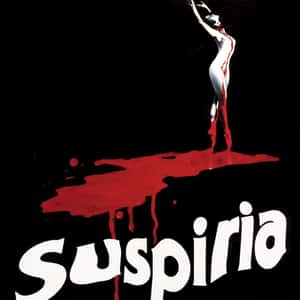
With gorgeous cinematography, vibrant and masterful use of colors, and one of the strangest and most out-of-control stories of witchcraft of all time, Suspiria perfectly encapsulates psychedelic horror in its visual and tonal styles. Showcasing grotesque and horrifying images of dreadful acts of violence, the film is a 99-minute nightmare-fueled trip that will have audiences feel as though they just went on the worst acid trip of their lives but saw some of the prettiest moments of murder in any film. Shocking, jarring, gorgeous, and unforgettable, Suspiria is one trip audiences will never forget.
- # 251 of 396 on The Best Horror Movies Of All Time
- # 153 of 199 on The Best Movies Of The '70s, Ranked
- # 71 of 77 on The 75+ Best Horror Franchises, Ranked By Scary Movie Fans
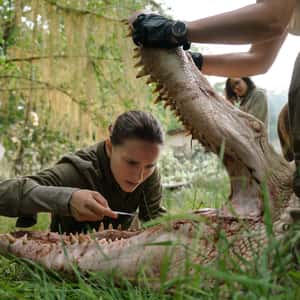
Annihilation
Annihilation is a gorgeous slow burn that dares to ask profound, bombastic, and spine-chilling questions about life and humanity, all while slowly delving into complete and utter madness. A film that beautifully encapsulates the slow and impending dread of a bad trip, things in the film start off relatively normal until each passing second shows audiences that they aren't in Kansas anymore, and things are very quickly about to go off the rails. Crescendoing into one of the most hallucinatory, intoxicating, and perfect final acts in sci-fi history, audiences will be floored by the time the credits roll and question the very meaning of reality.
- # 100 of 178 on The 150+ Best Movies With Aliens
- # 256 of 396 on The Best Horror Movies Of All Time
- # 73 of 92 on The 95+ Greatest Dystopian Action Movies

The Lighthouse
Robert Pattinson and Willem Dafoe work as two lighthouse keepers in Robert Egger's The Lighthouse , and that bit of information is about as normal as the film will get for its subsequent 109-minute runtime. Slowly delving further and further into the macabre mouth of madness, The Lighthouse is a film designed to break and tear apart audiences' minds piece by piece until they are simply a shell of the person they entered the movie as. A film that is unrelenting in its weirdness but beloved for its willingness to push the envelop, The Lighthouse is a one-of-a-kind experience that will stick with audiences for a lifetime.
- # 151 of 252 on The 200+ Best Psychological Thrillers Of All Time
- # 86 of 91 on The 90 Best Black And White Movies
- # 23 of 79 on Great Period Movies Set in the 19th Century

The Neon Demon
Sometimes psychedelic horror movies don't need a sweeping epic story or profound characters, sometimes they just need a gorgeous backdrop to do some weird stuff, and no film does weird stuff more often or better than Nicolas Winding Refn's The Neon Demon . Almost all of Winding Refn's work has the tang of incomprehensibility about them, but The Neon Demon fully embraces the madness and takes the macabre and dangerous to another level. The film fascinating trip that will have audiences both amazed and dumbfounded by the time the credits roll.
- # 5 of 45 on Great Movies with a Neon Aesthetic
- # 14 of 15 on 15 Love-Em-Or-Hate-Em Horror Movies That Split Audiences Down The Middle
- # 5 of 15 on Horror Movie Endings People Only Pretend To Understand

Under the Skin
One of the most polarizing and divisive horror films to release in the last 20 years, Under the Skin is a devilishly seductive, sensual, and intoxicating experience that is almost guaranteed to blow audiences' minds. Following an alien who seduces men only to take them back to her place and horrifyingly rip them apart in both the literal and metaphorical sense of the word, Under the Skin is not a fun-filled psychedelic experience, instead, a film that feels as though it was a psychedelic movie made that slowly morphed into the realm of terror, and once it realized it was there, never turned back.
- # 309 of 396 on The Best Horror Movies Of All Time
- # 23 of 45 on Great Movies with a Neon Aesthetic
- # 55 of 62 on The Best Alien Horror Movies Ever Made

While most people hear the term psychedelic and think of groovy hippies on acid, the true meaning behind this stingy little word is the strange, mind-melting, and world-altering states it has on the human body. While some trips are good, some are very, very bad, and no film offers up audiences a more grounded and realistic portrayal of a bad trip than Phil Tippett's Mad God . An almost silent stop-motion horror film, Mad God features horrifying images, grotesque and almost vomit-inducing moments of terror, and an incoherent mess of a story that will show all the non-drug users out there exactly what a bad high can feel like.
- # 10 of 14 on Weird Horror Films That Are Mind-Bogglingly Disturbing
- # 17 of 111 on 110+ Movies And Shows With Mad In The Title
- # 11 of 13 on The 13 Best Fantasy Horror Movies Of All Time

A horror film seeming made by people on drugs, for people on drugs, Andrzej Zulawski's Possession is one of the most unhinged, unapologetic, and intoxicating horror films ever made. Brutal in its direction, masochistic in its visual style, and unrelenting in its feats of terror, Possession is a mind-melting film that showcases the beauty of the horror genre, as the story is just tight enough to keep audiences entertained by mad enough to continue to one-up itself until audiences are relegated to witnessing some of the vilest images ever put on screen.
- # 64 of 75 on The Best Movies Of 1981
- # 293 of 396 on The Best Horror Movies Of All Time
- # 18 of 20 on 20 Shocking Horror Movie Endings That Took You by Surprise
- Entertainment
- Graveyard Shift
- Watchworthy
Lists of the greatest, worst, goriest, and scariest horror movies, series, characters, scenes, and more.


Horror Trip: The Vampire
We’re extremely excited to start a new bi-weekly series here on Bloody-Disgusting that’s called Horror Trip ! Hosted by RagnarRox, Horror Trip will take a popular topic in horror and analyze it from a historical and philosophical perspective, ultimately becoming an educational yet still highly entertaining video series that gives you a broader understanding of where some of our favorite tropes, characters, myths and legends came from.
We’re kicking off the series today by diving into the realm of Vampires! While many of us know that the first mainstream vampire character was Bram Stoker’s Dracula , the myths of vampires go much further back in and come from a wide variety of cultures.
Join Ragnar as he takes you on a trip through vampiric history!
Ragnar Ulricson, older than he looks and nicer than you think. When he doesn’t make videos about horror stuff and video games on his mildly successful YouTube channel RagnarRox, he works as a (formerly 9-to-5, now independent 24/7) game designer and also loves long, relaxing walks on the beach.
Check him out on YouTube , Facebook , Twitter , or consider buying him a coffee on Patreon !
Managing editor/music guy/social media fella of Bloody-Disgusting

You may like

[Watch] YouTuber RagnarRox Releases New ‘Shadow Man Remastered’ Retrospective Doc, With Discount Code For GOG Version of The Game

The Blood is Life: A Brief History of Vampires in Film

Horror Trip: Body Horror
‘Heathers’ – 1980s Satire Is Sharper Than Ever 35 Years Later
“ When I was just a little girl I asked my mother, what will I be? Will I be pretty? Will I be rich? Here’s what she said to me: Qué será, será. Whatever will be, will be ”
The opening of Michael Lehmann’s Heathers begins with a dreamy cover of a familiar song. Angelic voices ask a mother to predict the future only to be met with an infuriating response: “whatever will be, will be.” Her answer is most likely intended to present a life of limitless possibility, but as the introduction to a film devoid of competent parents, it feels like a noncommittal platitude. Heathers is filled with teenagers looking for guidance only to be let down by one adult after another. Gen Xers and elder millennials may have glamorized the outlandish fashion and creative slang while drooling over a smoking hot killer couple, but the violent film now packs an ominous punch. 35 years later , those who enjoyed Heathers in its original run may have more in common with the story’s parents than its teens. That’s right, Lehmann’s Heathers is now old enough to worry about its kids.
Veronica Sawyer ( Winona Ryder ) is the newest member of Westerberg High’s most popular clique. Heather Chandler ( Kim Walker ), sits atop this extreme social hierarchy ruling her minions and classmates alike with callous cruelty and massive shoulder pads. When Veronica begins dating a mysterious new student nicknamed J.D. ( Christian Slater ), they bond over hatred for her horrendous “friends.” After a vicious fight, a prank designed to knock Heather off her high horse goes terribly wrong and the icy mean girl winds up dead on her bedroom floor. Veronica and J.D. frantically stage a suicide, unwittingly making Heather more popular than ever. But who will step in to fill her patent leather shoes? With an ill-conceived plan to reset the social order, has Veronica created an even more dangerous monster?
Heathers debuted near the end of an era. John Hughes ruled ’80s teen cinema with instant classics like Sixteen Candles , The Breakfast Club , and Ferris Bueller’s Day Off while the Brat Pack dominated headlines with devil-may-care antics and sexy vibes. The decade also saw the rise of the slasher; a formulaic subgenre in which students are picked off one by one. Heathers combines these two trends in a biting satire that challenges the feel-good conclusions of Hughes and his ilk. Rather than a relatable loser who wins a date with the handsome jock or a loveable misfit who stands up to a soulless principal, Lehmann’s film exists in a world of extremes. The popular kids are vapid monsters, the geeks are barely human, the outcasts are psychopaths, and the adults are laughably incompetent. Veronica and a select few of her classmates feel like human beings, but the rest are outsized archetypes designed to push the teen comedy genre to its outer limits.

Mean girls have existed in fiction ever since Cinderella’s wicked stepsisters tried to steal her man, but modern iterations arguably date back to Rizzo (Stockard Channing, Grease ) and Chris Hargenson (Nancy Allen, Carrie ). It might destroy Heather Chandler to know that she isn’t the first, but this iconic mean girl may be the most extreme. She knows exactly what her classmates think of her and uses her power to make others suffer. She reminds Veronica, “They all want me as a friend or a fuck. I’m worshiped at Westerburg and I’m only a junior.” With an icy glare and barely concealed rage, she stomps the halls playing cruel pranks and demanding her friends submit to her will. We see a brief glimpse of humanity at a frat party when she’s coerced into a sexual act, but she immediately squanders this good will by promising to destroy Veronica at school on Monday. However, the film does not revolve around Heather’s redemption and it doesn’t revel in her ruination. Lehmann is more concerned with how Veronica uses her own popularity than the way she dispatches her best friend/enemy. In her book Unlikeable Female Characters: The Women Pop Culture Wants You to Hate , Anna Bogutskaya describes Heather Chandler as an evolution in female characterization and it’s refreshing to see a woman play such an unapologetic villain.
Heather Chandler may die in the film’s first act, but her legacy can still be felt in both film and TV. Shannen Doherty would go on to specialize in catty characters both onscreen and off while Walker’s performance inspired the 2004 comedy Mean Girls (directed by Mark Waters, brother of Heathers screenwriter Daniel Waters). Early seasons of Buffy the Vampire Slayer, Dawson’s Creek , Gossip Girl , and Pretty Little Liars all feature at least one glamorous bitch and mean girls can currently be seen battling on HBO’s Euphoria . Tina Fey’s Regina George (Rachel McAdams) sparked an important dialogue about female bullying and modern iterations add humanity to this contemptible character. With a rageful spit at her reflection in the mirror, Walker’s Heather hints at a deep well of pain beneath her unthinkable cruelty and we’ve been examining the motivations of her followers ever since.
But Heather Chandler is not the film’s major antagonist. While the blond junior roams the cafeteria insulting her classmates with an inane lunchtime poll, a true psychopath watches from the corner. J.D. lives with his construction magnate father and has spent his teenage years bouncing around from school to school. At first, Veronica is impressed with his frank morality and compassion for Heather’s victims, but this righteous altruism hides an inner darkness. The cafeteria scene ends with J.D. pulling a gun on two jocks and shooting them with blanks. This “prank” earns him a light suspension and a bad boy reputation, but it’s an uncomfortable precursor to our violent reality. He’s a prototypical school shooter obsessed with death, likely in response to his own traumatic past.

It’s impossible to talk about J.D. without mentioning the Columbine High School Massacre of 1999. Just over ten years later, Eric Harris and Dylan Klebold would murder one teacher and twelve of their fellow classmates while failing to ignite a bomb that would decimate the building. Rumors swirled in the immediate aftermath about trench coat-wearing outcasts targeting popular students, but these theories have been largely disproven. However, uncomfortable parallels persist. Harris convinced a fellow student to join him in murder with tactics similar to the manipulation J.D. uses on Veronica. The cinematic character also fails in a plan to blow up the school and the stories of all three young men end in suicide. There is no evidence to suggest the Columbine killers were inspired by Slater’s performance but these similarities lend an uncomfortable element of prophecy to an already dark film.
In the past 35 years, we’ve become acutely aware of the adolescent potential for destruction. Unfortunately the adults of Heathers have their heads in the sand. We watch darkly humorous faculty meetings in which teachers discuss what they believe to be suicides and openly weigh the value of one student over the next. The only grownup who seems to care is Ms. Fleming ( Penelope Milford ) the guidance counselor and even she is woefully out of touch. Using dated hippie language, she stages an event where she pressures her students to hold hands and emote. Unfortunately she’s more interested in helping herself. Hoping to capitalize on her own empathy, she invites TV cameras to film her students grieving for their friends. She treats the decision to stay alive like she would the choice between colleges and asks Veronia about her own suspected suicide attempt with the same banality Heather brings to the lunchtime polls. This self-involved counselor is only interested in recording the answer, not actually connecting with the students she’s supposed to be guiding.

We also see a shocking lack of support from the film’s parents. J.D. and his father have fallen into a bizarre role-reversal with J.D. adopting the persona of a ’50s-era sitcom dad and his father that of an obedient son. Like Ms. Fleming’s performance, these practiced exchanges are meant to project the illusion of love while maintaining emotional distance between parent and child. Veronica’s own folks display similar detachment in vapid conversations repeated nearly word for word. They go through the motions of communication without actually saying anything of substance. When Veronica tries to talk about the deaths of her friends, her mother cuts her off with a cold, “you’ll live.” The next time Mrs. Sawyer ( Jennifer Rhodes ) sees her daughter, she’s hanging from the ceiling. Fortunately Veronica has staged this suicide to deceive J.D., but it’s only in perceived death that we see genuine empathy from her mother.
Another parent is not so lucky. J.D. has concocted an elaborate scene to murder jocks Kurt ( Lance Fenton ) and Ram ( Patrick Labyorteaux ) in the guise of a joint suicide between clandestined lovers and the world now believes his ruse. At the crowded funeral, a grief-stricken father stands next to a coffin wailing, “I love my dead gay son” while J.D. wonders from the pews if he would have this same compassion if his son was alive. It’s a brutal moment of truth in an outlandish film. Perhaps better parenting could have prevented Kurt from becoming the kind of bully J.D. would target. We now have a better understanding about the emotional support teenagers need, but the students in Heathers have been thrown to the wolves.
At the same funeral, Veronica sees a little girl crying in the front row. She not only witnesses the collateral damage she’s caused, but realizes that future generations are watching her behavior. She is showing young girls that social change is only possible through violence and others are copying this deadly trend. Despite the popular song Teenage Suicide (Don’t Do It!) by Big Fun, two other students attempt to take their own lives. Her teen angst has a growing body count and murdering her bullies has only turned them into martyrs.

Heathers delivers a somewhat happy ending by black comedy standards. After watching J.D. blow himself up, Veronica saunters back into school with a newfound freedom. She confronts Heather Duke (Doherty), the school’s reigning mean girl queen, and takes the symbolic red scrunchie out of her hair. Veronica declares herself the new sheriff in town and immediately begins her rule by making a friend. She approaches a severely bullied student and makes a date to watch videos on the night of the prom, using her popularity to lift someone else up. She’s learned on her own that taking out one Heather opens the door for someone else to step into the vacuum. The only way to combat toxic cruelty is to normalize acts of generosity. Rather than destroying her enemies, she will lead the school with kindness.
Heathers concludes with another rendition of “Que Sera, Sera.” In a more modern cover, a soloist delivers an informal answer hinting at a brighter future. We still don’t know what the future holds, but we don’t have to adhere to the social hierarchy we’ve inherited. We each have the power to decide what “will be” if we’re brave enough to separate ourselves from the popular crowd. The generation who watched Heathers as children are now raising their own teens and kids. One can only hope we’ve learned the lessons of this sharp satire. The future’s not ours to see, but if we guide our children with honesty and compassion, maybe we’ll raise a generation of Veronicas instead.

Party City Releasing Life-Size ‘Terrifier 2’ Art the Clown & Little Pale Girl Animatronics!

6 Other Experimental Slashers to Watch Before ‘In a Violent Nature’

‘It Doesn’t Get Any Better Than This’ Review – Found Footage Movie Won ‘Best Feature’ at Salem Horror Fest

“Crystal Lake” – A24 Has NOT Pulled the Plug on Their ‘Friday the 13th’ TV Series [Exclusive]

‘The Substance’ – First Look at ‘Revenge’ Director’s Body Horror Movie

You must be logged in to post a comment.
- Cambridge Dictionary +Plus
Translation of Horrortrip – German-English dictionary
(Translation of Horrortrip from the GLOBAL German–English Dictionary © 2018 K Dictionaries Ltd)

Word of the Day
Your browser doesn't support HTML5 audio
a unit for measuring the loudness of sound

Varied and diverse (Talking about differences, Part 1)

Learn more with +Plus
- Recent and Recommended {{#preferredDictionaries}} {{name}} {{/preferredDictionaries}}
- Definitions Clear explanations of natural written and spoken English English Learner’s Dictionary Essential British English Essential American English
- Grammar and thesaurus Usage explanations of natural written and spoken English Grammar Thesaurus
- Pronunciation British and American pronunciations with audio English Pronunciation
- English–Chinese (Simplified) Chinese (Simplified)–English
- English–Chinese (Traditional) Chinese (Traditional)–English
- English–Dutch Dutch–English
- English–French French–English
- English–German German–English
- English–Indonesian Indonesian–English
- English–Italian Italian–English
- English–Japanese Japanese–English
- English–Norwegian Norwegian–English
- English–Polish Polish–English
- English–Portuguese Portuguese–English
- English–Spanish Spanish–English
- English–Swedish Swedish–English
- Dictionary +Plus Word Lists
- GLOBAL German–English Noun
- All translations
To add Horrortrip to a word list please sign up or log in.
Add Horrortrip to one of your lists below, or create a new one.
{{message}}
Something went wrong.
There was a problem sending your report.
- Download Shazam
- Radio Spins
Acid Dreams
Trippy robot, music video.

Featured In
Shazam footer.
- Help for Apple Devices
- Help for Android Devices
- ShazamKit for Developers
- Privacy Policy
- Manage Your Data
Top Songs By Trippy Robot
- BREAKING NEWS Car-to-car shooting on 10 Fwy in Covina leaves 1 dead; EB lanes closed Full Story
- shark attack
Florida man survives being bitten by sharks in 'feeding frenzy' after falling off boat in Bahamas

A Florida man is recovering after being bitten by not one - but two sharks - after falling into the water in the Bahamas. Now, he's sharing his terrifying story of survival.
"Next second, I'm in the water with, you know, a lot of sharks. I knew immediately, I gotta get back in the boat or this is gonna be really bad," said Marlin Wakeman.
The 24-year-old was on a fishing trip in the southern Bahamas late last month when he fell into the water.
"I was still holding on to the boat when I got bit," Wakeman recalled.
Wakeman says the waters in Clarencetown's Flying Fish Marina are infested with dozens of sharks, and is known as a popular spot to clean fish and throw scraps.
RELATED: 10-year-old boy suffers shark bite in Bahamas, closing experience
"These sharks have learned that there is regular amounts of food being tossed into the ocean here from these fishermen," said Ron Magill, director of communications & wildlife expert at Zoo Miami. "When they get into that feeding frenzy, they're out there to compete against other sharks. They want to get as much food as they can as quickly as they can."
"When I was underwater it was, you know, two seconds. And mainly the worst thing I thought was, you know, I don't want to get eaten by 10 sharks," Wakeman said.
Wakeman was stitched up in the Bahamas and flew back home to Florida the next day. Doctors believe the shark was at least seven feet long and his wound is over a foot long. It just missed his artery.
ALSO SEE: 73-year-old diver nearly loses life, says shark attack was like horror movie
"The fact that there's 20 sharks in there and you were able to get out of there and still have a leg is amazing," said Dr. Robert Borrego, a trauma surgeon at St. Mary's Medical Center.
"I realized, you know, how lucky I got," Wakeman said. "It was just, you know -- thanking my angels."
Wildlife experts say if you do end up in the water and there are sharks, obviously, try to get out as quickly as possible. But experts also say to fight. Punch the shark in the nose since it is a sensitive area and can often deter an animal.
Related Topics
- WILD ANIMALS
- U.S. & WORLD
- SHARK ATTACK
Shark Attack

Bahamas shark experience temporarily closes after boy bitten

Woman in critical condition after being bitten by shark at NYC beach

Shark attack, encounters raise concerns ahead of holiday weekend

Diver nearly loses life, says shark attack was like horror movie
Top stories.

Long Beach police release bodycam video of deadly shooting at park

18-year-old charged in wild fight at The Pike Outlets in Long Beach

Hollywood businesses set up garden beds to clear homeless tents

Photo of 'smiling' bear near Pasadena becomes social media sensation

Newsom would slash 10K vacant state jobs to help close $27.6B deficit
Pomona College moves commencement amid protest on graduation stage
IE family terrified after hidden camera found recording their home
Northern Lights may be visible in parts of CA overnight

IMAGES
VIDEO
COMMENTS
Ein Horrortrip (engl. bad trip) ist ein akuter, sehr negativ erlebter und von starken Angstzuständen begleiteter Rauschzustand. Er kann unter Einfluss verschiedener psychotroper Substanzen - insbesondere Halluzinogenen - auftreten. Personen, die einen Horrortrip erleben, haben Panikanfälle, das Gefühl des Alleinseins, Verlust der Selbstwahrnehmung, Depersonalisation, Derealisation ...
/r/Drogen soll weder für Drogen werben, noch deren Nutzung verteufeln. Es soll vielmehr eine Plattform sein für eine sachliche Diskussion über den Umgang mit Drogen zu verschiedenen Zeiten und in verschiedenen Gesellschaften. ... Ich glaube man kann schon sagen dass es wenn es spaß macht nicht in die definition von "horror trip" fällt ...
20% Rabatt auf den Projektor 3000 "Chill":https://www.open-mind-shop.com/discount/koma20?redirect=%2Fproducts%2Fprojektor-3000-version-chill(Rabattcode "Kom...
Horror-Trip. Nach dem Konsum von Halluzinogenen - manchmal auch nach Cannabiskonsum - kann es zu einer sogenannten drogeninduzierten Psychose kommen. Dabei empfinden die Betroffenen meist starke Angst bis Panik und sind stark erregt. Die Wahrnehmung ist wahnhaft verändert, meist mit paranoider Prägung. Dies kann im Extremfall soweit gehen, dass die Betroffenen Selbstmord begehen bzw. es ...
What It's Like to Trip on DMT. Everything to know about the hallucinogenic "spirit molecule"—common side effects include seeing aliens and finally connecting with the universe. MH. by ...
Jonas*, 31, erzählt von seinem Bad Trip auf LSD. Er hat mit verschiedenen Drogen Erfahrung (Cannabis, MDMA, Ketamin, Kokain, LSD). Ich war alles andere als unerfahren, als ich den schlimmsten ...
Wie man einen Cannabis-Horrortrip verhindert. Letztendlich ist ein schlechter Weed-Trip entweder auf Deinen psychischen Zustand oder den Konsum von zu viel Gras zurückzuführen. Im Folgenden wirst Du herausfinden, wie Du ein schlechtes Cannabiserlebnis verhinderst, um gar nicht erst auf dieser Horrorwelle reiten zu müssen: Reinige Deinen Geist.
7.2 on IMDb — 72% on RT. Watch on Amazon. Directed by Terry Gilliam. Starring Johnny Depp, Benicio Del Toro, Tobey Maguire. Adventure, Comedy, Drama (1h 58m) 7.5 on IMDb — 50% on RT. Watch on Amazon. It's one thing to watch someone take drugs. It's another to experience what they're going through.
Über Erfahrungen dieser Art berichten Menschen, die halluzinogene Drogen wie Psilocybin eingenommen haben. Forscher von der Johns Hopkins University School of Medicine haben nun festgestellt, dass die Wahrscheinlichkeit, einen solchen Horrortrip zu erleben, von der Persönlichkeit abhängt. Roland Griffiths und seine Kollegen befragten online ...
By MICHAEL POLLAN. Illustrations by CHRISTOPH NIEMANN MAY 15, 2018. My first psilocybin journey began around an altar in the middle of a second-story loft in a suburb of a small city on the ...
Horror-Trip auch unter erfahrenen Konsumierenden. Studienleiter Roland Griffiths und sein Team von der Johns Hopkins Universität in den USA baten die Befragten, sich an ihren schlimmsten Horror-Trip auf Pilzen zu erinnern und Angaben hierzu zu machen. Wie durchaus zu erwarten war, haben überwiegend Personen teilgenommen, die mehrmals ...
Rated: 8.5/10 • May 19, 2022. In Theaters At Home TV Shows. Following her daughter's suicide, a grief-stricken mother is visited by an unconventional therapist who offers a hallucinogenic drug ...
Erinnert ihr euch an den Abschnitt im ersten Teil, indem ich über den hängengebliebenen Typen gesprochen habe? Ich hätte nie gedacht, dass mir etwas ähnliche...
/r/Drogen bietet die Möglichkeit sich sowohl über legale Drogen wie Kaffee, Alkohol, Tabak und Psychopharmaka, als auch illegale Drogen wie Cannabis, Opioide und Psychedelika, sowie "Grauzonen"-Produkte, sogenannte Legal Highs und Research-Chemicals, auszutauschen. ... Hey Leute, habe eine Frage zum Thema Horror Trip. Ich erkläre euch mal ...
General question what's the most scariest trip you had out of pure delusion not anything psychical in your way.
Sie hat einen regelrechten Verfolgungswahn, vermutet überall Polizei, sieht Dämonen, die ihr nach dem Leben trachten und beschuldigt eine Klassenkameradin, e...
WEGEN HHC IM KOMA - DROGEN HORROR TRIP. Jun 7, 2023. #vorzeitig Danke für euren Support!... Join to unlock. 1. 3. Locked. Get more from Simon Ruane. 128. Unlock 128 exclusive posts. Be part of the community. Connect via private message. See options. Simon Ruane. creating Youtubevideos über Drogen.
Panos Cosmatos delivered to audiences one of the most wild, sadistic, vibrant, and abnormal films of all time with his 2018 masterpiece Mandy.A film that is purposely designed to feel like a bad trip, the stunning artwork and visual style mixed with some of the most grotesque and disgusting imagery every put to screen is all but guaranteed to freak audiences out, and Nicolas Cage giving one of ...
When he doesn't make videos about horror stuff and video games on his mildly successful YouTube channel RagnarRox, he works as a (formerly 9-to-5, now independent 24/7) game designer and also ...
Horrortrip translations: horror trip, horror trip. Learn more in the Cambridge German-English Dictionary.
Horror Trip Trippy Robot. Drogen Sind Schlimm Trippy Robot. Unlimited Fantasy Trippy Robot. Der böse Buhmann Trippy Robot. I'm Back Trippy Robot. Show Me What You Got Trippy Robot. Trippy Thoughts Trippy Robot. Feel the Energy Trippy Robot. Summer Breeze Trippy Robot. Credits.
Wer in Thailand mit Drogen dealt, muss, wenn er erwischt wird, mit lebenslanger Haft oder sogar der Todesstrafe rechnen!Horror Trips - Wenn Reisen zum Albtra...
The 24-year-old was on a fishing trip in the southern Bahamas late last month when he fell into the water. ... ALSO SEE: 73-year-old diver nearly loses life, says shark attack was like horror movie
Endlich ist es soweit! Die CDs zu meinem Album Schattenwelt sind ab sofort verfügbar! Wenn ihr mich und meine Arbeit unterstützen wollt, dann gönnt euch ein ...